Jude The Tourist


Cabadbaran City Top 10 Tourist Spots: Exploring the Uncharted Treasures
- September 19, 2023
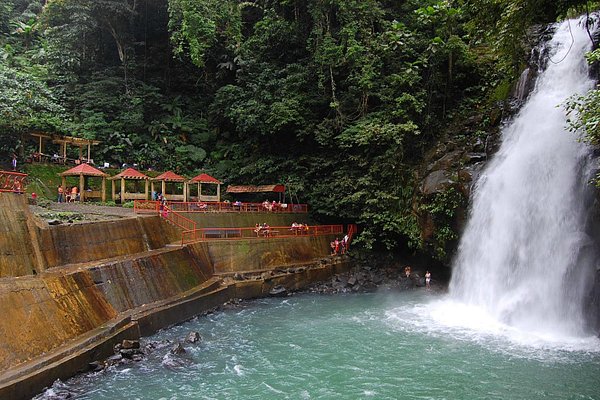
Higanteng Bato
A day well spent:.
One of the treasures of Cabadbaran’s history is steeped in antiquity, reaching back to 1200 A.D. Ancient villages from the 12th century once thrived along the region’s waterways, such as Caasinan, Cambuayon, and Capudlusan. These pre-Spanish Cabadbaranon’s shared an era with the archaeological sites in Butuan City, and today, their treasures can be explored at the Cabadbaran City Artifacts Gallery, temporarily housed at the City Library.
https://www.dpwh.gov.ph/
During the early years of Spanish colonization, historical records are sparse, with only a single site in Sanghan providing evidence of Chinese ceramics dating back to the 15th and 16th centuries.
In 1867, Cabadbaran first emerged in history as a small village chosen by Spanish authorities for a new reduction, known as “La Reunion de Cabarbaran.” It absorbed the local population, including people from Bunawan, Talacogon, and Solibao, who were compelled to move by Spanish authorities. However, La Reunion was disbanded in 1879, prompting the return of upper Agusan’s inhabitants to their original places, while the rest of the population integrated into Tubay.
What is Cabadbaran City known for?
Cabadbaran, formally recognized as the City of Cabadbaran (Cebuano: Dakbayan sa Cabadbaran), holds the status of a sixth-class component city and serves as the de jure capital of Agusan del Norte province in the Philippines. As of the 2020 census, it boasts a population of 80,354 individuals.
Established in 1894, this city has transitioned from its early Spanish colonial roots to emerge as the leading municipality in Agusan del Norte. Its cultural wealth is prominently displayed through the well-preserved colonial-era houses and an impressive array of archaeological treasure.
How to get to Cabadbaran?
Reaching Cabadbaran City in Agusan del Norte, offers several transportation choices tailored to your starting point and preferences.
Here are the available options :
The closest airport to Cabadbaran City is Bancasi Airport in Butuan City, approximately 60 kilometers away. Upon arrival, you can pick for a taxi or van ride to reach Cabadbaran City.
Numerous bus companies provide regular services to Cabadbaran City from various Mindanao locations, including Cagayan de Oro, Davao, and Surigao City. Well-known bus operators in the region include Bachelor Express, Rural Transit, and Super 5.
By Car or Motorbike :
If you have your own vehicle, Cabadbaran City can be accessed by driving via the national highway connecting other major Mindanao cities. Alternatively, you can rent a car or motorbike from rental agencies in nearby cities like Butuan and Surigao.
If you are traveling from Visayas or Luzon, you can board a ferry to nearby port towns such as Surigao or Nasipit. From there, you can continue your journey to Cabadbaran City by bus or van.
In summary, Cabadbaran City offers various transportation options, allowing you to choose the most convenient one based on your departure location and budget.
http://www.maplandia.com/philippines/region-10/agusan-del-norte/cabadbaran
Cabadbaran City offers a variety of activities and places to explore, including:
Pongkay prayer mountain.
A serene and spiritually significant destination with a challenging ascent and a tranquil atmosphere for reflection and meditation.
Tumipi Cold Spring
A pristine oasis with clear waters, perfect for swimming and picnics, known for its therapeutic qualities.
Atega Ancestral House
A historic Spanish-era house with a fusion of architectural influences, offering a glimpse into the city’s past.
Dagkot Festival
An annual cultural celebration featuring colorful costumes, traditional dances, and music performances that showcase the city’s heritage.
Virgen de la Candelaria Parish
A revered church dedicated to the Blessed Virgin Mary, known for its candle-lighting tradition during Holy Week.
A monumental rock formation that stands as a geological marvel, surrounded by tranquil waters and natural beauty.
These are the Activities and Places to Explore in Cabadbaran City
Nestled amidst the scenic beauty of Cabadbaran, the Prayer Mountain stands as a testament to both natural splendor and spiritual reverence. Located in the heart of Barangay Kauswagan, this enchanting destination beckons travelers and seekers alike with its promise of tranquility and spiritual enlightenment. Accessing this sacred site is a breeze, as it’s just a short 15-minute tricycle ride away from the bus terminal, making it easily reachable for visitors from near and far.
Known far and wide, the Prayer Mountain is a beloved gem among the locals, and its presence is a source of pride for the community. With an ascent consisting of approximately 700+ steps, it offers a moderate challenge that takes roughly 30 minutes to an hour to conquer. The best time to start this ascent is in the early morning, around 5 am, just as the first rays of sunlight gently kiss the landscape. This serene hour allows visitors to experience the mountain in a unique and tranquil ambiance, making it an ideal time for reflection and meditation.
As you ascend the Prayer Mountain, you’ll not only feel your physical exertion but also a sense of spiritual awakening. The mountain’s tranquil environment, combined with the invigorating climb, creates an atmosphere conducive to deep contemplation and connection with the divine. To enter this hallowed ground, there is a nominal entrance fee of just 10 pesos. This fee goes towards the upkeep and maintenance of the Prayer Mountain, ensuring that it remains a pristine and sacred place for generations to come. The responsibility for its maintenance falls upon the Saladaga family, respected and cherished members of the Cabadbaran community.
They have collaborated with the local government and some private individuals to transform this mountain into a place of spiritual solace and natural beauty of treasures . As you stand atop the Prayer Mountain, gazing at the horizon painted with the colors of dawn, you’ll understand why this place is revered by both locals and visitors. It’s a space that transcends the physical world, offering a glimpse into the spiritual realm and a deep sense of connection to the universe. So, whether you seek a physical challenge, spiritual awakening, or simply a moment of serene contemplation, the Prayer Mountain in Cabadbaran awaits, ready to embrace your journey of self-discovery and inner peace.
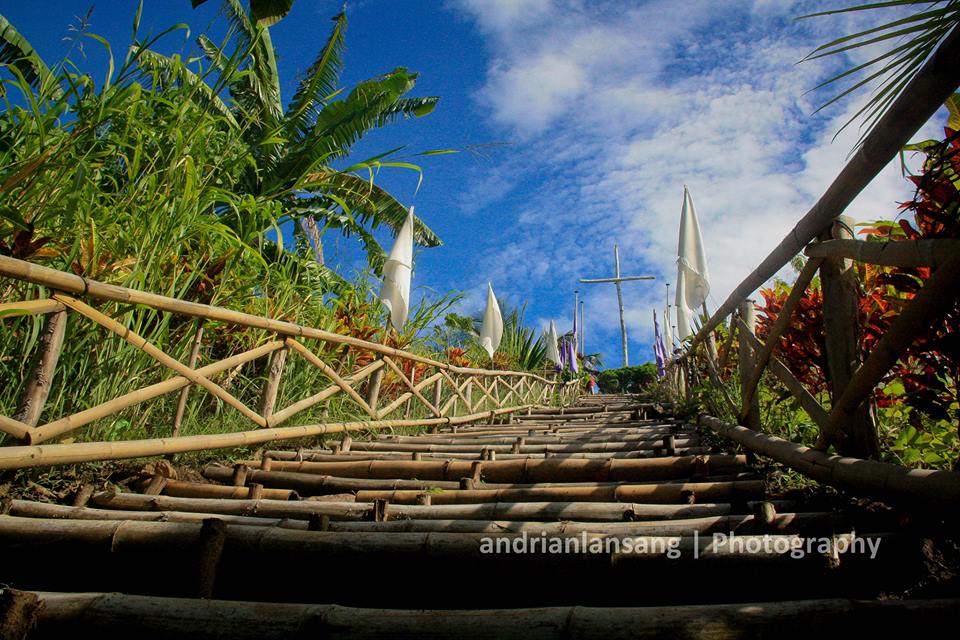
https://www.facebook.com/photo/?fbid=662251097159484&set=a.333528573365073
Nestled amid the picturesque landscapes of Cabadbaran lies the enchanting Tumipi Spring, a hidden oasis known for its pristine, crystal-clear waters. This natural wonder offers a serene escape from the hustle and bustle of city life, inviting visitors to bask in its beauty and tranquility. The Tumipi Spring is a sanctuary for nature enthusiasts and those seeking respite from the daily grind. The moment you arrive, you’ll be greeted by the soothing sounds of gently flowing water and the vibrant hues of lush greenery that envelop this idyllic spot.
It’s a paradise for those who appreciate the simple joys of life and the serene embrace of Mother Nature. One of the primary attractions of Tumipi Spring is its inviting waters, which are not only clear but also refreshing. The spring’s pristine quality makes it an ideal destination for a refreshing swim, allowing visitors to cool off and rejuvenate amidst nature’s splendor. Whether you’re a seasoned swimmer or just looking to dip your toes, the spring’s inviting waters promise a memorable experience.Beyond swimming,
Tumipi Spring offers a range of activities for visitors of all ages. The spacious surroundings make it perfect for picnics, where families and friends can gather for a delightful outdoor meal. Imagine enjoying a picnic by the spring, the soothing sounds of nature providing the soundtrack to your meal—a truly tranquil and memorable experience. The convenience of reaching Tumipi Spring adds to its allure. Whether you have your own vehicle or prefer to explore the area by motorbike, the spring is easily accessible, allowing you to embark on your journey of relaxation without hassle.
Moreover, for those who wish to extend their stay, there are several resorts and cottages nearby, offering comfortable accommodations amidst the serenity of nature. Spending a night in this tranquil environment allows you to fully immerse yourself in the experience, waking up to the gentle rustle of leaves and the symphony of birdsong.Tumipi Spring isn’t just a destination; it’s an oasis of tranquility and natural beauty.
It’s a place where the worries of the world fade away, replaced by the soothing embrace of clear waters and lush greenery. Whether you seek adventure, relaxation, or a touch of both, Tumipi Spring welcomes you with open arms, promising an unforgettable journey into the heart of Cabadbaran’s serene and rejuvenating natural wonders.
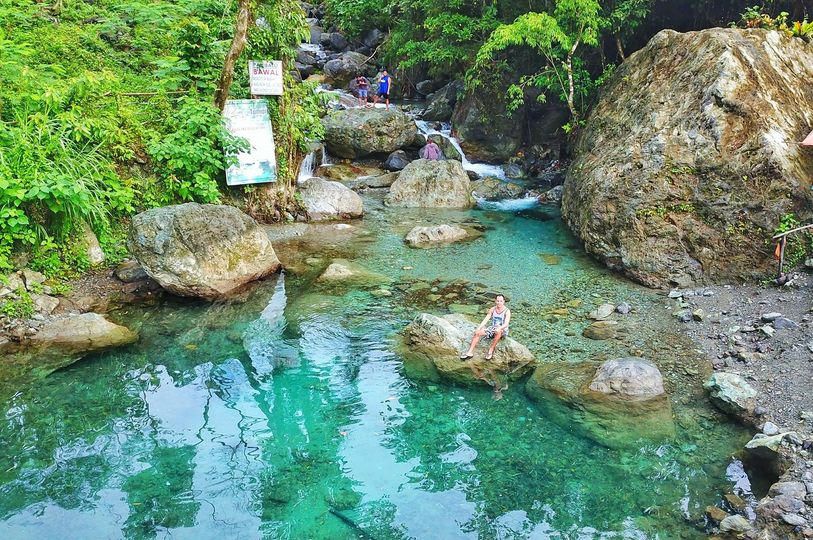
https://www.facebook.com/caragaregion/posts/clear-jaded-water-tumipi-cold-spring-puting-bato-cabadbaran-citysource-marlon-vi/10156269935759258/
Among the array of old Spanish architectural treasures, the Atega Ancestral Home stands as the most remarkable, nestled in Caraga.
Constructed in 1904, the Atega House served as the residence for the Atega family, whose lineage traces back to Spanish Friar Father Pedro Garcia. It was commissioned by Don Andres Atega, a revolutionary leader, and has undergone expansions over the years due to the family’s practice of not dividing their properties. Today, it boasts an impressive 36 rooms and a lush garden.
Interestingly, the house’s garden was originally a swampy terrain inhabited by deer. A fortunate turn of events occurred when a flood transformed the area into a suitable garden.
The interior design is a fusion of Filipino, Chinese, and European influences. The room doors seamlessly blend with the walls, providing a discreet appearance from the outside, which served as an advantage during wartime. Upon entering, one is struck by the spaciousness of the rooms, a stark contrast to the house’s unassuming exterior.
While the house is adorned with numerous “old” and “antique” artifacts, it also incorporates modern furnishings and decorations, as some members of the Atega family still reside there. Additionally, it serves as accommodations for friends and family who visit Cabadbaran City from time to time.
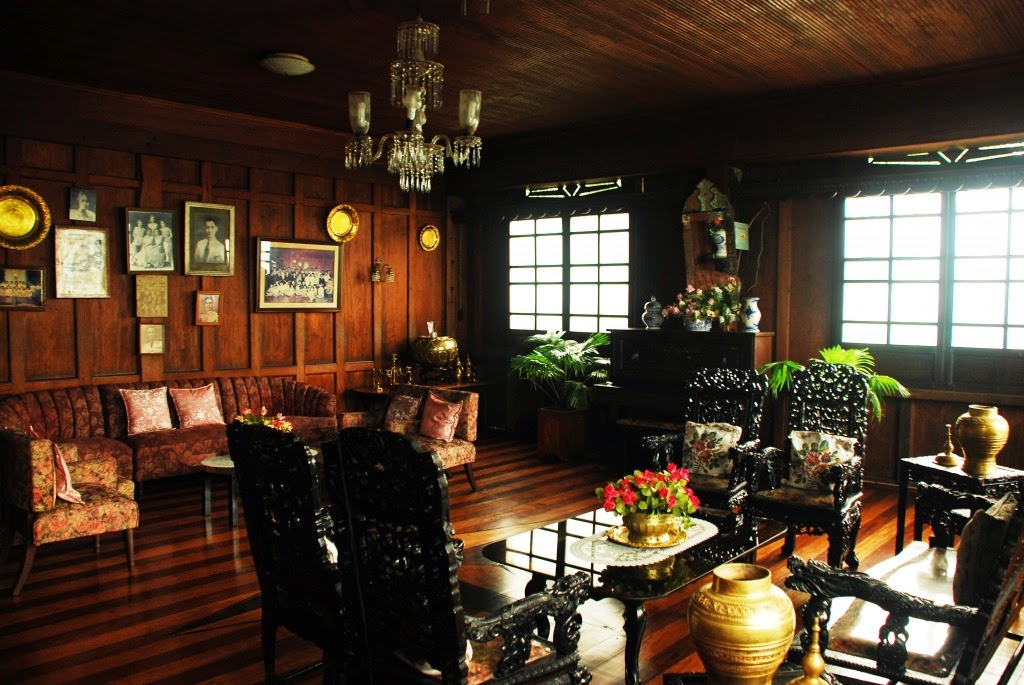
http://touristportalph.blogspot.com/
The Dagkot Festival is an annual celebration that unfolds every second of February in Cabadbaran City. This festival is deeply rooted in the city’s cultural heritage and derives its name from the local term “Dagkot,” which translates to “to pull.”
During this vibrant event, participants don colorful costumes and engage in traditional dances and music performances as they grace the city’s streets with a lively parade. The festival also includes a spirited street dance competition where groups vie against each other to showcase their finest dance moves and choreography.
Beyond the cultural festivities, the Dagkot Festival serves as a trade fair, a gastronomic extravaganza, and hosts various activities that promote the city’s tourism industry. It has gained popularity in Cabadbaran City and attracts visitors from all corners of the Philippines and around the world.
Whether you’re eager to delve into Cabadbaran’s rich history and culture or simply bask in the area’s natural beauty, this hidden gem in Agusan del Norte offers something for everyone.
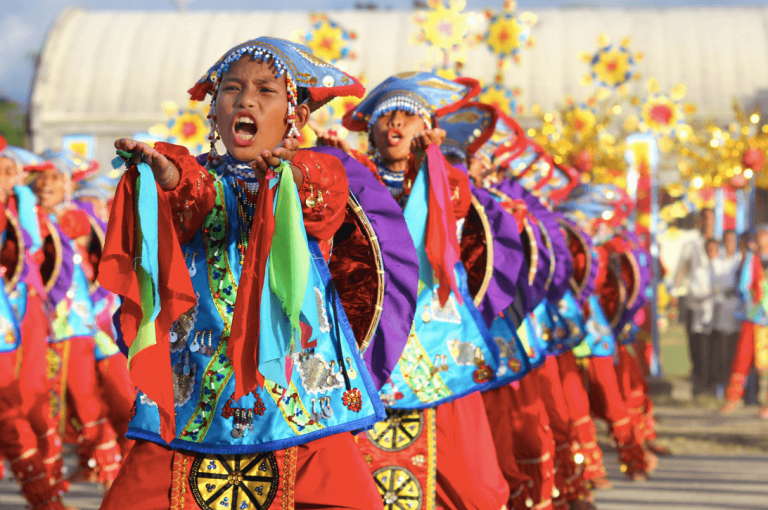
https://lakwatsap.wordpress.com/
The Our Lady of Presentation Parish Church is among the most revered churches in Agusan Del Norte, dedicated to honoring the Blessed Virgin Mary under the title of the Lady of the Candle. Devotees flock to this church to light candles, a symbolic gesture of gratitude and the conveyance of heartfelt wishes to the heavens.
When you visit the Our Lady of Presentation Parish Church during Holy Week and your Visita Iglesia in Agusan Del Norte, you’ll be struck by the profusion of candles adorning its interior. What’s particularly remarkable is the sight of the church brilliantly illuminated when numerous devotees congregate to offer prayers with their candles to the Holy Mother of God. Given these compelling elements, the Our Lady of Presentation Parish is unquestionably one of the essential stops among the seven churches to visit in Agusan Del Norte.
In the aftermath of the destructive typhoon of 1876, Fr. Urios took the initiative to encourage the residents of Jabongan to seek higher ground for the construction of a permanent church. Construction efforts were commenced by Fr. Chambo, SJ, in 1878, and the church was consecrated by Fr. Llobera, SJ, during the celebration of Corpus Christi on June 17, 1897. This historical treasure church stands today as the oldest Spanish church in the entire Caraga region.
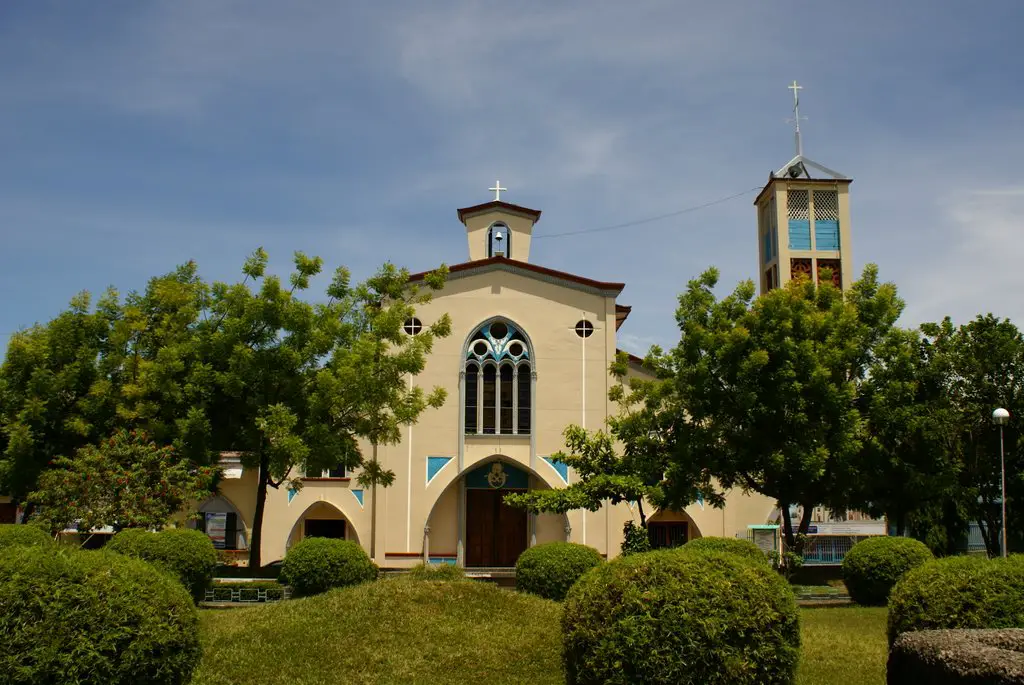
https://mapio.net/
Nestled within the picturesque landscapes of Cabadbaran City in Agusan del Norte, you’ll discover the awe-inspiring wonder known as the “Higanteng Bato” or the Giant Rock. This monumental rock formation stands as a testament to nature’s grandeur, captivating the hearts and minds of all who venture to witness its majesty.
The Giant Rock commands attention with its remarkable dimensions, measuring an impressive 124 meters in circumference, a staggering 31 meters in width, and soaring to a remarkable height of 54.13 feet. It proudly holds the distinction of being the largest stone in the entire province, a natural marvel that has intrigued and fascinated generations.
For those who embark on the journey to the “Higanteng Bato,” it’s not just a visit to a rock formation; it’s a pilgrimage to a place where nature’s artistry and geological marvels converge. It’s a chance to stand in awe of the colossal rock that has silently witnessed the passage of time and the evolution of the land it graces. As you explore this remarkable treasure site, you’ll be greeted by the soothing sounds of the nearby stream, the fresh scent of nature in the air, and the profound sense of wonder that only places like the “Higanteng Bato” can inspire.
Whether you’re a geology enthusiast, a nature lover, or simply someone seeking a moment of serenity amidst the grandeur of nature, this colossal stone formation in Cabadbaran City promises an unforgettable experience. So, set forth on this journey to discover the Giant Rock, where history, nature, and beauty converge in harmonious splendor.
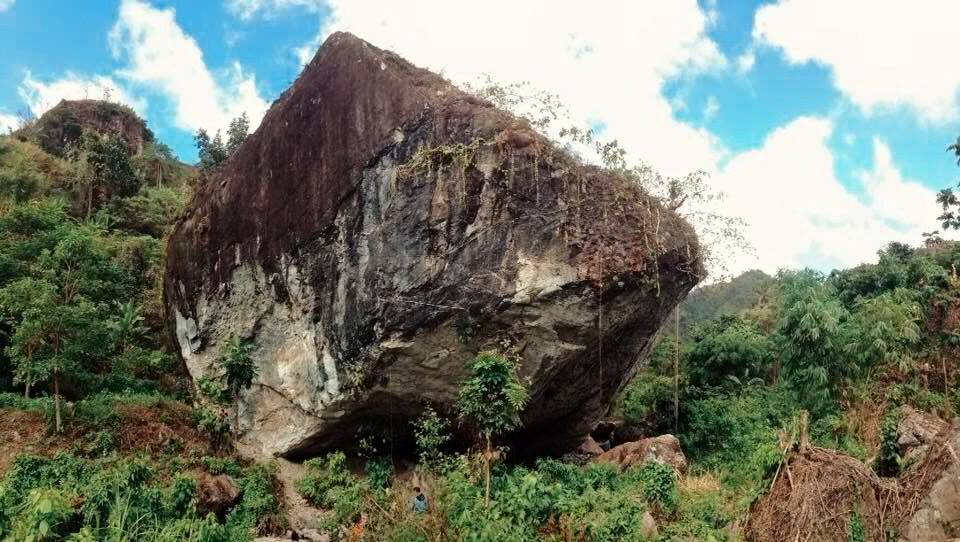
http://tarakahitsaan.com/
Why visit Cabadbaran?
Cabadbaran City takes immense pride in presenting a vibrant blend of culture’s treasure and eco-adventure. It showcases impeccably preserved ancestral homes and archaeological treasures that unveil its captivating historical odyssey. The city boasts breathtaking landscapes and offers a plethora of nature-based treasure activities, all complemented by delightful culinary delights, making it the perfect destination for a fulfilling day of treasure exploration.
There are several compelling reasons to visit Cabadbaran City:
Cultural riches:.
Cabadbaran City is steeped in culture, boasting well-preserved ancestral houses or treasure and archaeological artifacts that provide a window into its rich treasure historical heritage. Exploring these cultural treasures can be a fascinating journey into the city’s past.
Scenic Beauty:
The city is blessed with mesmerizing landscapes, offering visitors the opportunity to immerse themselves in natural beauty of treasure. Whether you’re interested in lush forests, pristine rivers, or serene mountains, Cabadbaran has it all.
Eco-Adventure:
For nature enthusiasts and adventure treasure seekers, Cabadbaran City is a haven. It offers a wide range of nature-based adventures, from hiking and trekking to river rafting and wildlife treasure exploration. The city’s natural resources provide ample opportunities for thrilling outdoor treasure activities.
Culinary Delights:
A visit to Cabadbaran wouldn’t be complete without indulging in its gastronomic treats. The city’s local cuisine offers a unique blend of flavors and ingredients, allowing you to savor delicious regional dishes and satisfy your taste buds.
Whether you’re interested in history, nature, adventure, or simply enjoying good food, Cabadbaran City has something for everyone. A day spent exploring the city promises to be a rewarding and memorable treasure experience.
In summary, Cabadbaran City’s cultural richness, natural beauty, eco-adventure opportunities, and culinary delights make it an enticing destination for travelers seeking a well-rounded and enjoyable treasure experience.
- best spots in Mindanao , cabadbaran city , philippines tourist destination , philippines tourist spots , tourist spots
Leave a Comment Cancel reply
Save my name, email, and website in this browser for the next time I comment.
Top Things to Do in Cabadbaran, Philippines
Places to visit in cabadbaran.
- Good for Kids
- Good for Big Groups
- Adventurous
- Budget-friendly
- Good for a Rainy Day
- Hidden Gems
- Good for Couples
- Honeymoon spot
- Good for Adrenaline Seekers
- Things to do ranked using Tripadvisor data including reviews, ratings, photos, and popularity.

1. Cabadbaran
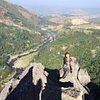
2. Our Lady of the Assumption Church
When In Manila Search
Cabadbaran city: where every story is a great adventure.
Cabadbaran City proudly offers a rich tapestry of culture and eco-adventure highlighted by well-preserved ancestral houses and archeological artifacts that unveil its historical journey, mesmerizing landscapes, nature-based adventures topped with gastronomic treats for a day well spent around the city.
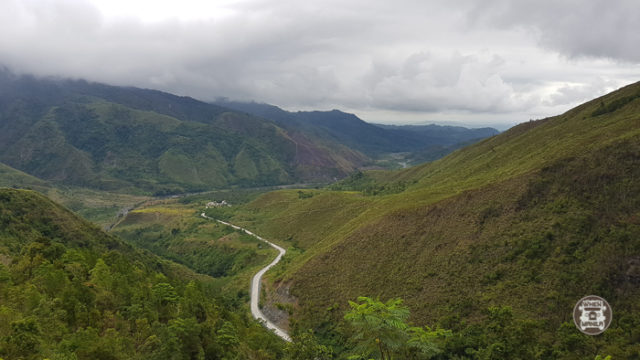
Located just 31 kms from Butuan Airport, Cabadbaran City is the capital of the province of Agusan del Norte with budding tourism potential slowly carving its niche in the tourism market. The city’s subtle offerings usher in adventure seekers and cultural aficionados, giving them a sweet surprise of how the city’s unassuming tourism has charmed them nonetheless. And so they come back and visit again. Just check out this video which gives you a taste of the adventure that awaits you in Cabadbaran:

We capped it off with the great food found in Cabadbaran City.
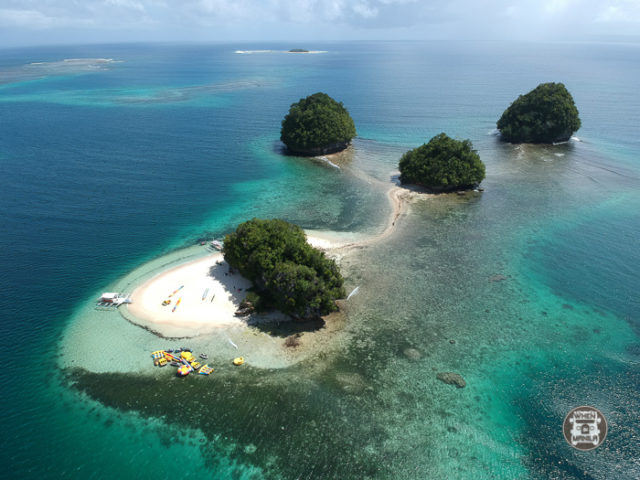
It also proves to be a gateway to many other beautiful destinations in the Caraga region.
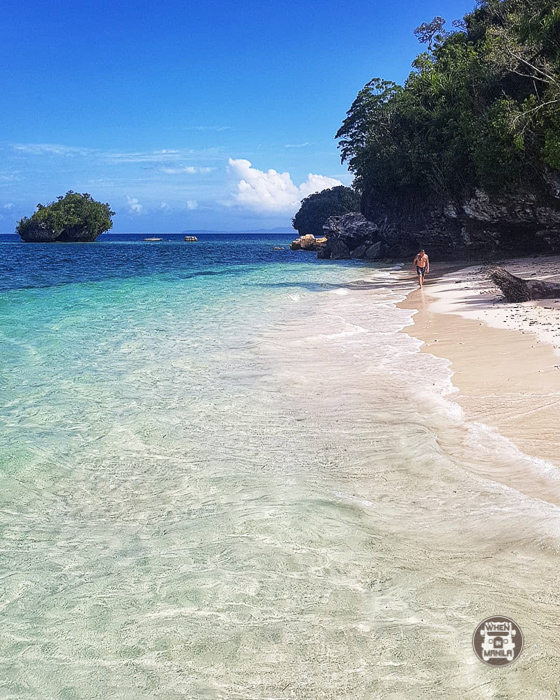
If you’re looking for a refreshing adventure where you can discover parts of the Philippines you never knew about, get in touch with Backyard Adventures PH. Since they’re locals in the area, you’re in for some off-the-beaten-track fun – from beaches to camping to biking to everything about nature, you’ll be able to quench that adventurous thirst in your soul in no time.
Backyard Adventures PH
Agusan del Norte, CARAGA Region
09178247345
https://www.facebook.com/bckyardadventures/
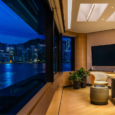
About The Author
Mocchachino-macchiato-driven-beach-lovin'-spa-addict-wedding-boudoir-and-lifestyle-photographer. A storyteller at heart with an eyegasmic awe of God's creations & love. www.arlenebriones.com

- Cabadbaran City, Agusan del Norte
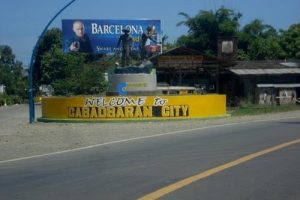
Cabadbaran City Rotunda
Cabadbaran’s pre-Spanish history can be traced down to 1,200 AD due to some traces of 12th century villages along waterways of the city. There are also artifacts of these pre-Spanish villages that can be found at the Cabadbaran City Artifacts Gallery, housed at the City Library. However, we have no records of what transpired in the city during the pre-Spanish years in the city.
Archival records showed that Cabadbaran was first mentioned in history as a small village chosen by Spanish authorities to become a new reduction which they called “La Reunion de Cabarbaran” in 1867. Added to the existing small population at that time were the inhabitants of Bunawan, Talacogon & Solibao who were coerced by Spanish authorities to migrate to La Reunion. Ten years later, in 1879, La Reunion was disbanded. Those from upper Agusan went back to their places of origin and the remnant population were attached to the town of Tubay.
The industry in Cabadbaran grew as they continued to produce abaca and rice. By 1930, local transportation became known in the town as the Agusan-Surigao road became serviceable. Among the bus lines that contributed to the towns economy was the MASTRANCO. When the Japanese entered the town and when the World War II started, the whole economy was affected.
When the independence was granted to the Philippines, the economy in Cabadbaran also boomed. Gold mining and logging contributed much for this growth. And by July 28, 2007, Cabadbaran became a city upon issuance of R.A. 9434.
Population/ Language/ Area
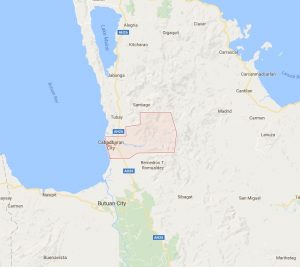
As of 2010, Cabadbaran has a population of 69, 241. Its land area spans up to 327.46 square kilometers.
The city belongs to the Second Climatic Type of the Corona Classification. No definite dry season in the place and maximum rainfall occurs from October to January. The average annual rainfall is 171.29 mm, average annual temperature 27.5 degrees.
Business Opportunity
The city has also a booming economy based on agro industry, commerce and trade, source of several export and industrial products; it has also varied ecotourism destinations ranging from Caraga’s highest peak, mile long tunnels to adventure tourism sites.
Easily accessible from the cities of Surigao and Butuan, the City has modern transport, communications, banking and accommodation facilities that could provide all the convenience a modern traveler needs.
Tourist Spots
- Cabadbaran Ancestral Houses – an old Spanish architecture houses. The most prominent among them is the Atega Ancestral Home, the biggest and most beautifully preserved house, located at Caraga.
- Cabadbaran Museum – a repository to the town’s old documents, as well as artifacts from Cabadbaran’s 4 archeological sites.
- Centennial Bitaug Tree – a 500-year old tree announced by the Philippine Centennial Commission as a centennial tree.

Stressed? Travel!
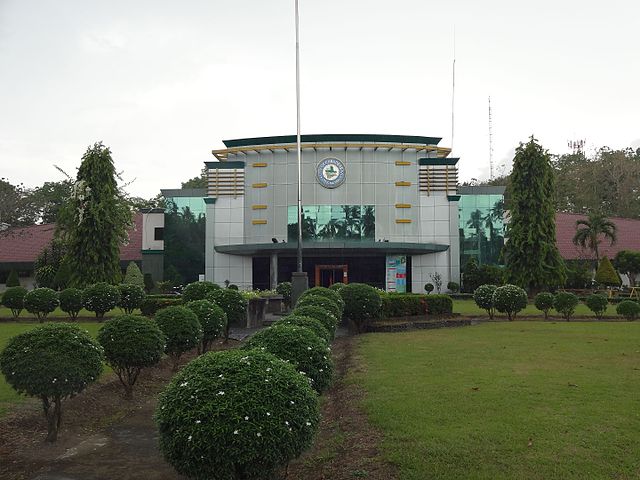
Cabadbaran Tourist Spots: Unveiling the Hidden Gems of the City
Nestled in the northeastern part of the Agusan del Norte, Cabadbaran City stands as a vibrant testament to the affluent cultural legacy and untamed beauty of the country. This charming city offers an array of hidden gems to be explored. The Cabadbaran tourist spots have their unique blend of historical, cultural, and natural attractions. They invite travelers to experience a different facet of the Philippines away from the usual hustle and bustle.
Cabadbaran Tourist Spots: Cabadbaran City Museum and Historical Center – Preserving Our Heritage

The Cabadbaran City Museum and Historical Center is a testament to the rich historical and cultural heritage of the city. Located in the heart of this vibrant community, the museum actively preserves and showcases the city’s past through its extensive collection of artifacts, photographs, and documents. Visitors can explore the city’s evolution from its humble beginnings to its current thriving state.
The museum’s commitment to education is evident, with well-curated exhibits that engage and inform. Its active role in promoting local history fosters a sense of pride among residents and deepens their understanding of Cabadbaran’s roots. As a living testament to the city’s past, present, and future, the Cabadbaran City Museum and Historical Center is vital in preserving our heritage for future generations.
Tourist Spots in Cabadbaran: The Majestic Mt. Hilong-Hilong
Mt. Hilong-Hilong, located in the Philippines, stands as a testament to the awe-inspiring beauty of nature. This towering peak, with its elevation of 2,012 meters above sea level, commands attention and reverence. Its lush, verdant slopes are adorned with various flora and fauna, making it a haven for biodiversity.
Hikers and nature enthusiasts experience breathtaking vistas when they visit Mt. Hilong-Hilong. The climb provides an exhilarating adventure for them. As one ascends, the rich tapestry of landscapes unfolds, from dense forests to pristine rivers. The mountain’s prominence also plays a crucial role in the local ecosystem, providing a habitat for numerous endangered species.
Preservation efforts and responsible tourism are essential to ensure that Mt. Hilong-Hilong remains a natural wonder for future generations. With its grandeur and ecological significance, Mt. Hilong-Hilong is an enduring symbol of the need to protect and appreciate the Earth’s natural treasures.
Pongkay Prayer Mountain: A Sacred Sanctuary for Spiritual Renewal
Pongkay Prayer Mountain is a revered haven for seekers of spiritual solace and enlightenment—this sacred retreat, adorned with serene natural beauty, beckons pilgrims and devotees alike. Perched at an elevation, it offers breathtaking vistas that inspire contemplation and prayer.
Visitors ascend the winding path, a symbolic journey of faith, leading to a peaceful sanctuary at its pinnacle. Here, active seekers partake in communal prayers and meditation, fostering a profound connection with the divine. The mountain’s tranquility and serenity provide a conducive atmosphere for introspection and self-discovery.
Pongkay Prayer Mountain is a testament to the enduring power of faith and the indomitable human spirit. It offers a respite from the chaos of daily life and a sanctuary for spiritual growth. It remains a cherished place where seekers find inner peace and renewal. Moreover, Mt. Pongkay is an invaluable asset for the local community and the broader spiritual community.
Tourist Spots in Cabadbaran: Casa Alburo – A Timeless Architectural Gem
Casa Alburo stands as a testament to architectural brilliance and historical significance. This majestic residence, located in the city’s heart, exudes an air of timeless grandeur and sophistication. It has seamlessly blended classical and neoclassical elements, showcasing meticulous craftsmanship.
The building’s façade, adorned with intricate detailing and classical columns, captivates passersby, inviting them to admire its timeless beauty. Inside, every room boasts exquisite craftsmanship, from ornate moldings to elegant chandeliers. Casa Alburo not only serves as a historical landmark but also as a living example of architectural excellence. It continues to inspire and enchant visitors, preserving the rich heritage of its era for generations to come.
Tourist Spots in Cabadbaran: Tumipi Cold Spring – A Refreshing Oasis of Natural Beauty
Nestled in the heart of lush tropical rainforests, Tumipi Cold Spring awaits discovery as a hidden gem. This pristine natural wonder, located in [insert location], is a testament to the captivating beauty of our planet. Crystal-clear waters gush forth from the depths of the Earth, creating a refreshing oasis that beckons travelers and nature enthusiasts alike.
Visitors can bask in the tranquility of this unspoiled paradise, where the refreshing cold waters offer respite from the tropical heat. The vibrant flora surrounding the spring adds to its allure, making it a picturesque spot for picnics and relaxation.
Tumipi Cold Spring is a testament to the enduring power of nature to inspire and rejuvenate. Its untouched beauty reminds us of our responsibility to safeguard and conserve these natural treasures for future generations.
Cabadbaran Tourist Spots: Atega Ancestral House – Preserving Heritage Through Time
The Atega Ancestral House is a testament to the rich cultural legacy and architectural wonders of the Philippines. This historic gem showcases the enduring legacy of Filipino craftsmanship and design. The house, characterized by its sturdy hardwood beams and intricately carved details, has withstood the test of time, weathering numerous challenges over the centuries.
Today, the Atega Ancestral House serves as a living museum. It offers visitors a glimpse into the past and a deep appreciation for the traditions and history of the region. Its well-preserved interior provides a vivid portrayal of daily life during the Spanish colonial era, offering an immersive experience that educates and inspires.
The dedication to its preservation is a testament to the commitment of the local community and heritage enthusiasts to ensure that future generations can continue to learn from and admire this remarkable piece of history . In the face of modernization, the Atega Ancestral House symbolizes cultural resilience and a vital link to our shared past.
Final Thoughts
Cabadbaran City, with its blend of natural splendors, cultural vibrancy, and historical significance, offers a multifaceted experience to travelers seeking to explore the less-traveled paths of the Philippines. The Cabadbaran tourist spots are a testament to the city’s enduring charm and a call to adventure for those eager to discover the hidden treasures of this remarkable region.
1 thought on “Cabadbaran Tourist Spots: Unveiling the Hidden Gems of the City”
Pingback: Cabanatuan Tourist Spots: You'll Love These Must-Visit Gems - Hop 'N Cruise
Leave a Comment Cancel Reply
Your email address will not be published. Required fields are marked *
- Car Rentals
- Airport Transfers
- Attractions & Tours
- Bundle & Save
- Destinations
- Trip.com Rewards
Things to Do in Cabadbaran City: Attractions & Tourist Spots (2024)
- Recommended
- Traveler Rating
- Most Booked
- Distance (Nearest First)

1 . Tumipi Cold Spring

2 . Cabadbaran Amusement Park

3 . St. Joseph Cathedral

4 . Sto. Nino Diocesan Shrine

5 . Balangay Shrine

6 . Sprinkles Water Park and Event Center

7 . Alicia’s Ridge

8 . Tagnote Falls

9 . Cantilan Public Market

10 . Bolihon Plaza Beach Resort
Popular types of attractions in cabadbaran city, popular restaurants in cabadbaran city, popular destinations, recommended attractions at popular destinations.
- Customer Support
- Service Guarantee
- More Service Info
- Website Feedback
- About Trip.com
- Terms & Conditions
- Privacy Statement
- About Trip.com Group
Other Services
- Investor Relations
- Affiliate Program
- List My Property
- Become a Supplier

Tours and Tickets

Most Recent: Reviews ordered by most recent publish date in descending order.
Detailed Reviews: Reviews ordered by recency and descriptiveness of user-identified themes such as wait time, length of visit, general tips, and location information.
Also popular with travelers
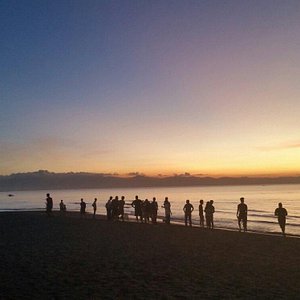
CABADBARAN: All You Need to Know BEFORE You Go (with Photos)
- (0.11 km) Bai Ding Garden Pensionne
- (0.93 km) Gazebo Pools & Restaurant
- (3.60 km) The Loreta Resort
- (0.47 km) Mande Pension House
- (1.86 km) Hidden Nav's Lodge
Caraga Region
Hub of beautiful places of Caraga Region
Surprising Sumag-a Falls, Mahaba, Cabadbaran City
November 11, 2020 by caraga Leave a Comment
Surprising Sumag-a Falls of Mahaba, Cabadbaran City is the most unique of all the waterfalls in Caraga Region. Aside from crystal clear and cold running water it has no river or streams above it but simply it goes nowhere but underground clear water breakout in the hilly part of Mahaba mountains.

Sumag-a falls has a man-made basin as a swimming pool where you can see the clearness of the waters before your eyes. The escape route of the flowing water is like forming a curtain of crystal wall onto the side of the pool before completely running away into the wilderness.
This how beauty exposed between the power of God and the talent of humankind blended in harmonious ways. When God created waterfalls and human created basin the result is surprising.

Many are asking where the water came from, but God has its own way of expressing it naturally that “God knows what we don’t know.” As they say “nothing is impossible under the heat of the sun.”

Amazing Saboro Falls, Barangay Mahaba, Cabadbaran City
November 10, 2020 by caraga Leave a Comment
Amazing Saboro Falls located at barangay Mahaba, Cabadbaran City, showers from the top and spreads like a wide curtain of crystals as it goes down to the basin. You will never get tired listening the sounds created of water splashing and passes into the rocks along the way. It stands tall exploring its creation as it surrounded with green vegetation of pure and wild natures.

Saboro Falls is unique in its own way flowing down in one path, compact and striking. Beautiful indeed!

When you haunt and discovered another waterfalls it seems you have in mind to compare the beauty of its creation, one thing for sure it will gives a lasting impression. How amazing and how unique could it be before the eyes of adventurer.

THE BEST Things to Do in Cabadbaran
Things to do in cabadbaran.
- Good for Kids
- Good for Big Groups
- Adventurous
- Budget-friendly
- Good for a Rainy Day
- Hidden Gems
- Good for Couples
- Honeymoon spot
- Good for Adrenaline Seekers
- Things to do ranked using Tripadvisor data including reviews, ratings, photos, and popularity.

1. Cabadbaran

2. Our Lady of the Assumption Church

15 Top-Rated Tourist Attractions & Things to Do in Moscow
Written by Diana Bocco Updated Dec 23, 2023 We may earn a commission from affiliate links ( )
Moscow is one of Europe's most enigmatic destinations, home to a fascinating history and colorful, awe-inspiring architecture you won't find anywhere else in the world. Moscow might be one of the most populous cities in the world with over 11 million inhabitants, but this hasn't changed its strong cultural and social traditions.
Walk the cobblestone streets of the Red Square or the banks of the Moskva River early in the morning, and it's hard to tell what century you're in.
Tsarist architecture, must-see churches, and glamorous shopping opportunities blend together for a visual experience you won't forget. For ideas on what to see and do while visiting Russia, here's our list of top tourist attractions in Moscow.

1. Marvel at the Size of the Kremlin
2. catch a performance at the bolshoi theatre, 3. shop at the luxurious gum, 4. make your way into lenin's mausoleum, 5. spend an hour (or three) at red square, 6. discover history at the museum of cosmonautics, 7. ride the stunning moscow metro, 8. explore the moscow state integrated museum-reserve, 9. spend a rainy day at the tretyakov gallery, 10. walk up and down arbat street, 11. stop by the vdnkh all-russian exhibition centre, 12. wander around gorky park, where to stay in moscow for sightseeing, map of tourist attractions & things to do in moscow.
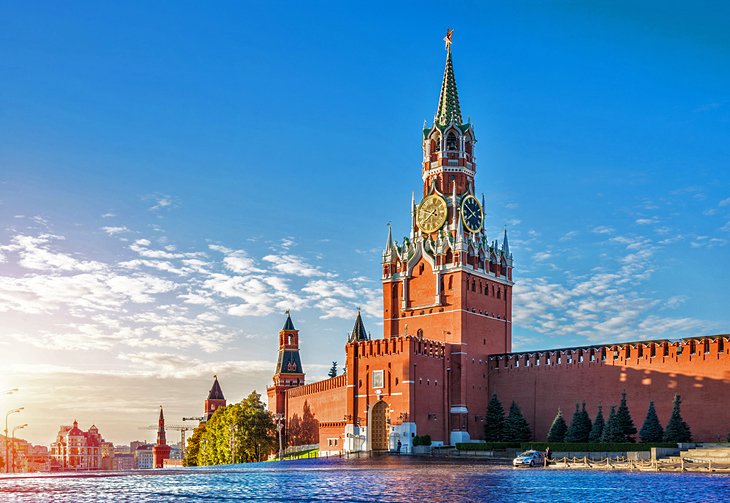
Moscow's most recognizable structure is without a doubt the Kremlin, a 15th-century fortified complex that covers an area of 275,000 square meters surrounded by walls built in the 1400s.
The Grand Kremlin Palace -which has over 700 rooms- was once home to the Tsar family and is now the official residence of the president of the Russian Federation, although most heads of state choose to reside elsewhere.
The massive complex also includes many other buildings, some of which are open to the public and can be visited regularly. Aside from three cathedrals (including one where the Tsars were once crowned) and a number of towers, the Kremlin is also home to the Armory building, a museum holding everything from the royal crown and imperial carriages to the ivory throne of Ivan the Terrible and Fabergé eggs.
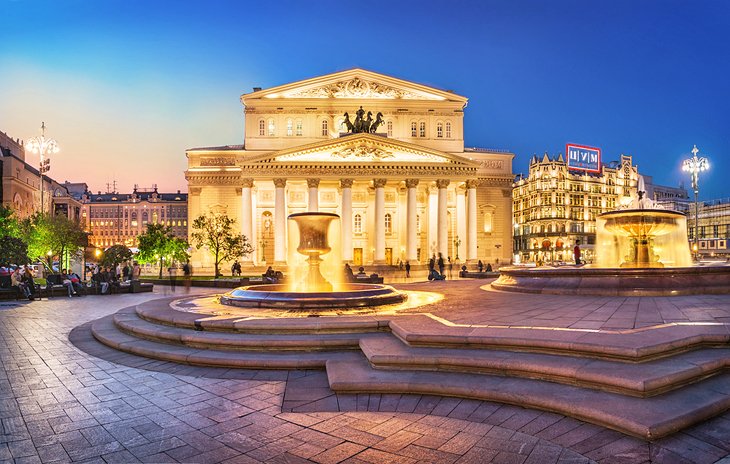
The Bolshoi Theater is home to the largest and one of the oldest ballet and opera companies in the world . While the theater has undergone several major renovations over the past century-including a recent one in 2011 to restore some of the imperial architectural details-it still retains all of its Neoclassical grandeur.
The Bolshoi Theater you see today opened in 1824, after several older versions burned down. Inside, red velvet, a three-tiered crystal chandelier, and gilt moldings give the place a Byzantine-Renassaince grandiose feel like no other.
Catching a show from the resident ballet and opera troupes is a treat, as the theater often presents a number of classic performances, such as Tchaikovsky's Mazeppa and Rachmaninoff's Francesca da Rimini, both of which originally premiered here.
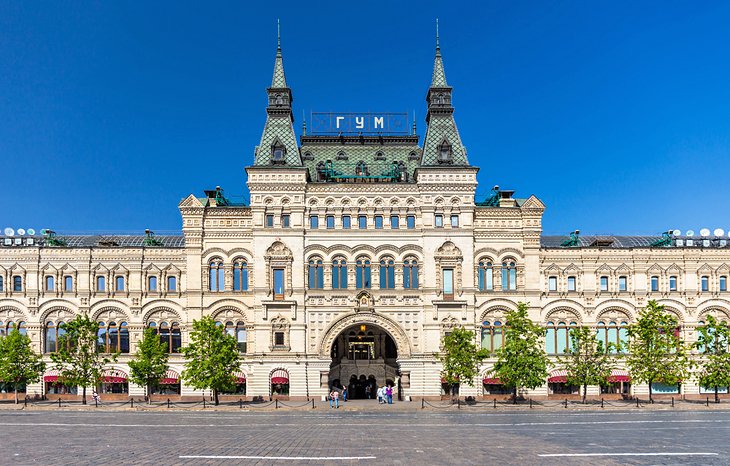
Moscow's oldest and most upscale shopping center is an architectural marvel. GUM (short for Glávnyj Universálnyj Magazín or "Main Universal Store") was built in the late 1800s in neo-Russian style to showcase a beautiful mix of a steel skeleton and 20,000 panels of glass forming an arched roof.
This was a unique construction at the time, since the glass had to be strong enough to support the snow-heavy Russian winters. The building is just as impressive outside, with all three levels covered in marble and granite.
While GUM is no longer the largest shopping center in Moscow, it's still by far the most beautiful. Home to brands like Gucci and Manolo Blahnik, this might not be the ideal destination for most budget-conscious visitors, but the beauty of the building itself is worth a visit.
On the third floor, there are also great dining options, including a Soviet-style canteen that serves traditional Russian food, and a stand selling ice cream made by hand using an original 1954 recipe originally approved by the Soviet government.
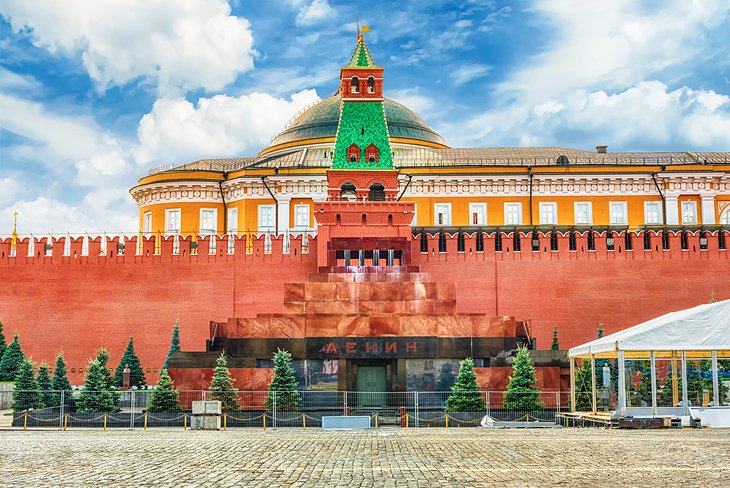
Lenin's Mausoleum, the final resting place of Soviet leader Vladimir Lenin, occupies a central spot in Red Square. His body has been in the mausoleum since his death in 1924-and although the original plan was for him to be buried after a short period of public display for mourning, the plan quickly changed.
After over 100,000 visited the tomb over a period of six weeks, it was decided that a new sarcophagus and a more permanent display space could actually preserve Lenin's body for much longer than expected-and Lenin's Mausoleum was built.
Over the years, the mausoleum and its marble stairs also became the main spot from where Soviet leaders would watch parades and events happening in Red Square.
Lenin's embalmed body can still be seen today, lying down in a bulletproof glass sarcophagus as if he's sleeping. While a visit to the mausoleum is certainly unusual, it has become a must-do for history buffs looking to understand how Lenin's legacy truly changed the nation. Come ready to wait, though -there are usually lines to get in.
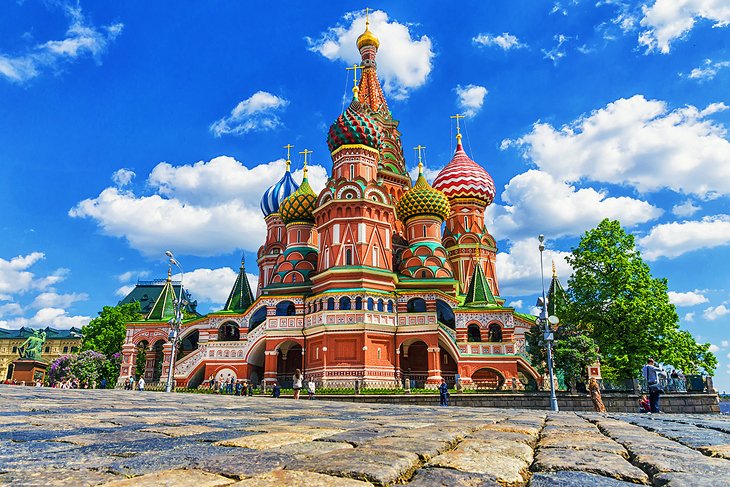
All of Moscow's main streets start at Red Square, so it's easy to see why this is considered the heart of the city. A massive space of 330 meters by 70 meters, the square is flanked by the Kremlin, Lenin's Mausoleum, two cathedrals, and the State Historical Museum.
In 1945, a massive Victory Parade was held here to celebrate the defeat of Nazi Germany by the Soviet Armed Forces.
St. Basil's Cathedral , one of the most recognizable buildings on the square, was built in 1555. The unique cathedral has architectural details inspired by Byzantine and Asian design, as well as details that resemble those found in famous mosques. There are nine individual chapels inside the church, all decorated with colorful mural art.
Both the square itself and the Kremlin are recognized as UNESCO World Heritage Sites . On weekends, there are sometimes stalls selling souvenirs and traditional items here, such as matryoshka (Russian nesting dolls), at the entrance of the square.
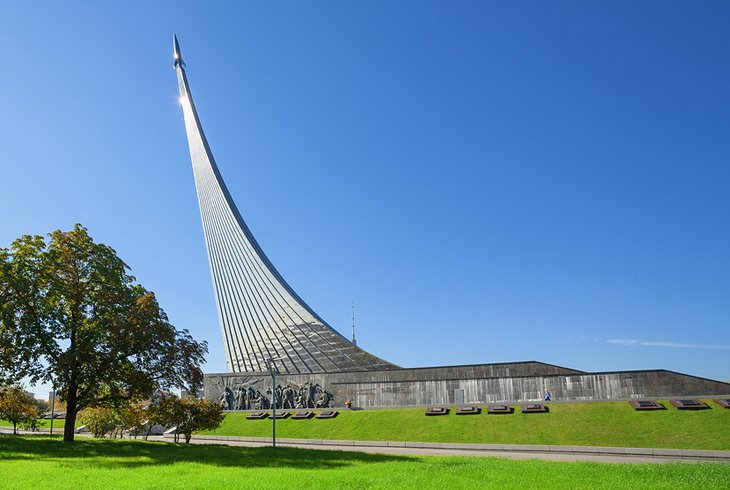
At one point, Russia and the US were toe-to-toe when it came to space exploration. While that might no longer be the case, the museum's amazing collection-which includes over 85,000 items-is still awe-inspiring.
Main exhibits include the space capsule used by Yuri Gagarin , the first human to travel into outer space; a USSR flag with moon fragments; a Soviet spacesuit; and a rocket propulsion unit from the 1960s. A special two-story hall showcases sections of the Mir space station interior, and there are also models of the first sputniks and a replica miniature spaceship.
English-language tours are available, and there's also a Cinema Hall showing subtitled short films about the history of space exploration programs and the first manned space flight.
The museum is located inside the base of the monument to the Conquerors of Space, which was built almost 20 years before the museum opened.
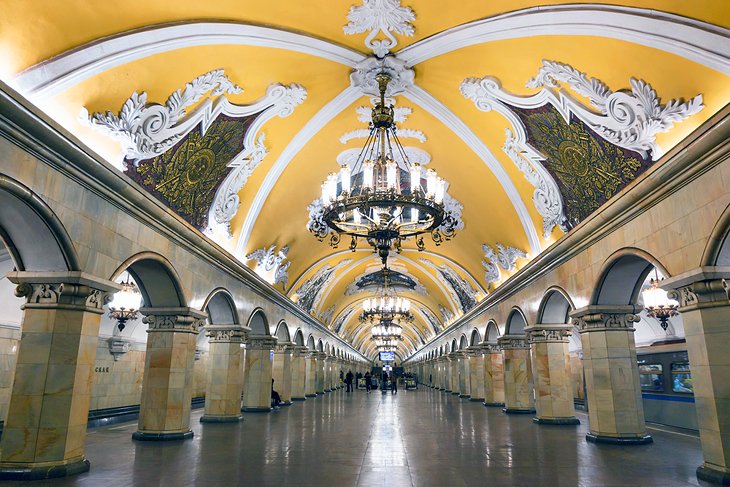
Riding the Moscow metro is an experience all in itself, but even just heading underground to walk through the stations is something no visitor should miss. With 223 stations and 12 metro lines crosscutting through Moscow, however, this can be tricky, so visiting at least a few of the most impressive ones is a good start.
Arbatskaya station was designed by a skyscraper architect, so it's no surprise that it features multicolored granite slabs and impressive bronze chandeliers.
Park Kultury station , located next to Gorky Park, is covered in marble and features reliefs of people involved in sports, while Teatralnaya station is decorated with porcelain figures dancing and wearing traditional Russian costumes.
The metro is open between 5:30am and 1:00am but it's very crowded in the early morning and after 4pm, so it's better to visit in the late morning or early afternoon to really appreciate the architecture without the crowds.
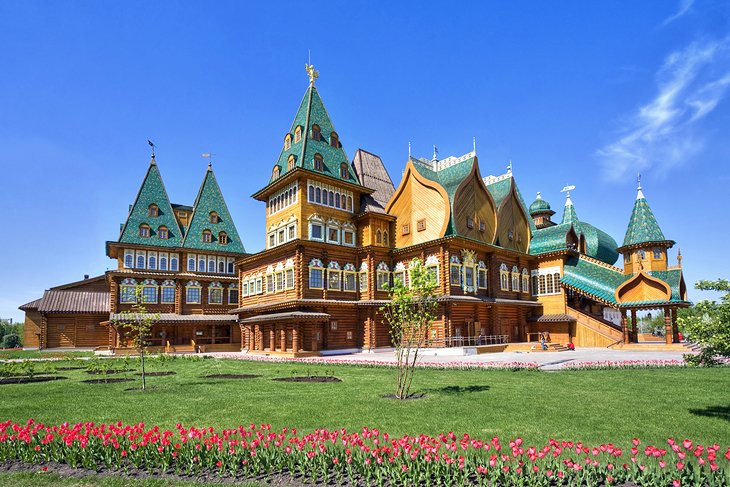
The Moscow State Integrated Art and Historical Architectural and Natural Landscape Museum-Reserve is a cultural open-air museum complex comprised of four different historical sites.
The most important site, the Kolomenskoye Estate, was once the summer residence of Tsars as far back as the 14 th century. The complex, which covers almost 300 hectares, is home to fairy-tale wooden palaces; a tent-roof stone church built in the 1500s; a water tower; fort towers and structures; and the 24-room Museum of Wooden Architecture , which includes the restored dining room of Tsar Alexei I.
Beautiful manicured gardens , riverside picnic areas, and a massive collection of both artifacts and structures make this a great destination to help you see what medieval Russia looked like. English-language tours are available, but you're also free to wander the grounds on your own.
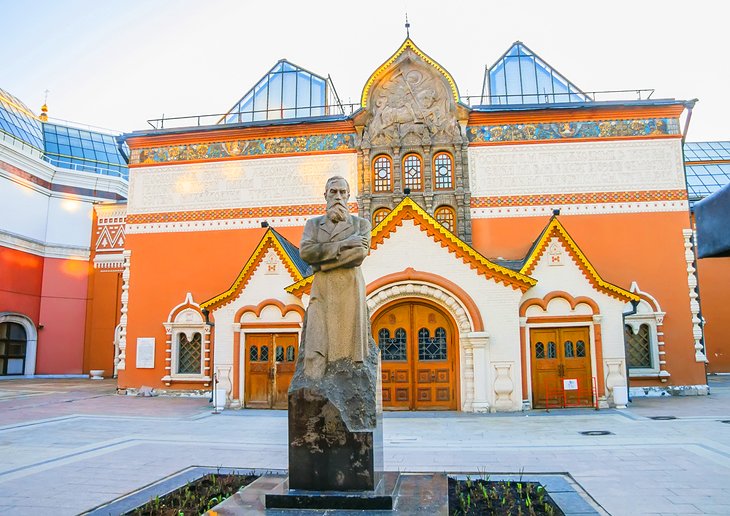
The largest collection of Russian art in the world sits here, with over 180,000 paintings, sculptures, and religious art dating back to over a millennia ago. The gallery, built using beautiful red and white colors from classical Russian architecture, is located near the Kremlin and it was built in the early 20 th century.
Significant art pieces include the Vladimir Mother of God; a Byzantine icon of the Virgin and child dating back to the 1100s; Andrei Rublev's The Trinity icon from the 15 th century; and several works by Ilya Repin, the most famous realist painter in Russia.
On the grounds of the museum, there is also an 86-meter-tall statue of Peter the Great, as well as a number of Socialist Realism sculptures.
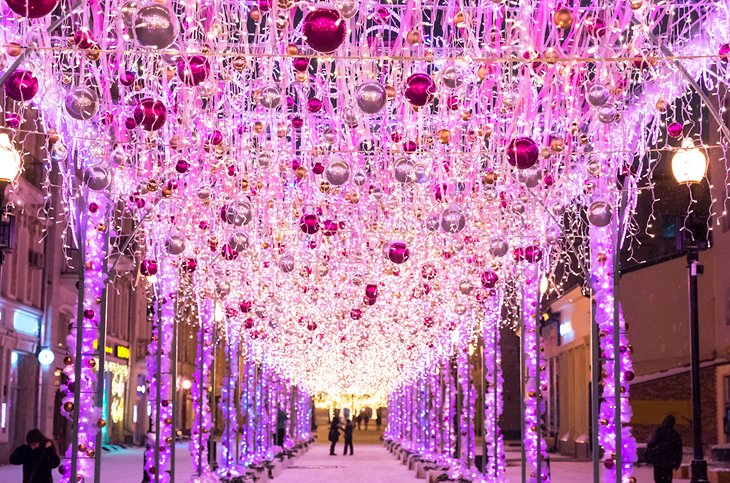
Moscow's one-kilometer-long pedestrian street has been around since the 15 th century. Originally a trade route in the outskirts of the city, Arbat Street is now very centrally located, home to posh buildings and lots of places to eat and shop.
Beautiful street lamps and two significant statues-one of Princess Turandot (from Puccini's last opera) and one of Soviet-era poet Bulat Okudzhava-adorn the street, which fills up with both locals and tourists on evenings and weekends.
A great place to pick up souvenirs or sit down at an outdoor café, Arbat Street also offers a chance to visit the former home of poet Alexander Pushkin and the café both Anton Chekhov and Leo Tolstoy used to visit.
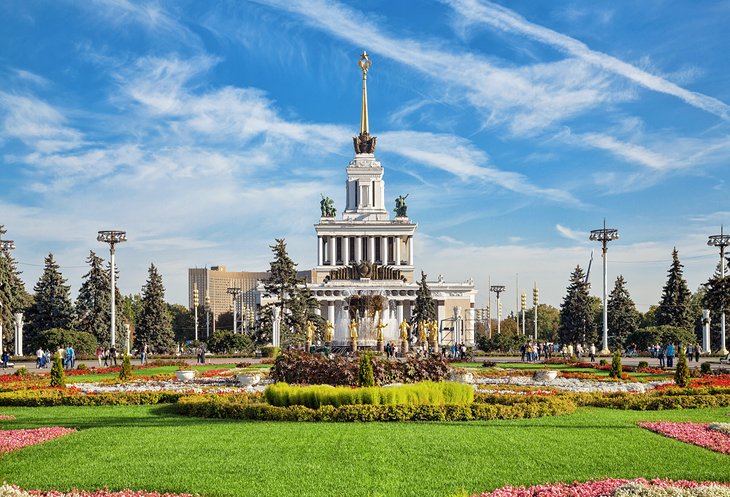
Although it was originally designed as a general-purpose trade show venue, this park complex now houses amusement rides , ice rinks , and a number of galleries and other attractions for all ages.
The park's most famous landmarks are the Moskvarium, a marine biology center home to over 8000 species of marine animals, the Garage Museum of Contemporary Art, and a shopping center selling traditional products from former Soviet countries.
There's even a film museum showing Soviet cartoons or even a full-length film (for an extra fee) and an education center offering masterclasses on everything from becoming a barista to video montage (call or write in advance to find out which ones are English-friendly).
Soviet-era pavilions, sculptures, and fountains abound here as well, including the famous Friendship of the Peoples Fountain, which features statues of women dressed in costumes from different former Soviet countries.
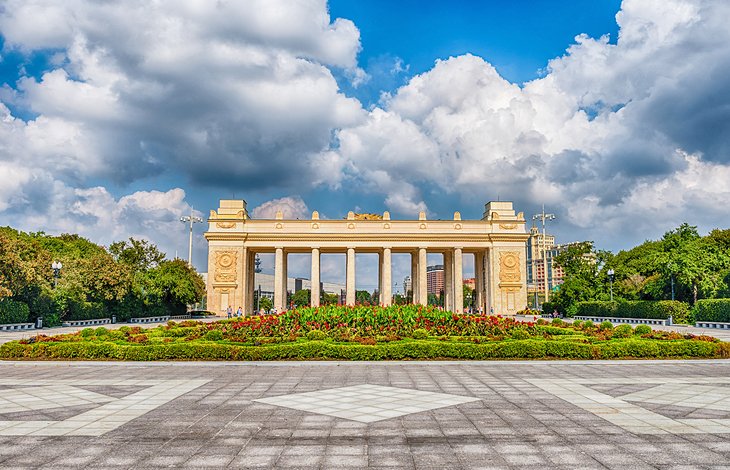
Named after the famous Russian writer Maxim Gorky (who was nominated for the Nobel Prize in Literature five times but never won it) and sitting right across the Moskva River, Gorky Park covers 120 hectares of beautiful ponds and green spaces.
Popular with both locals and tourists, the park offers a variety of things to enjoy-from sunbeds, hammocks, and drinking fountains to free yoga classes and children's playgrounds. There's free Wi-Fi and sockets for charging your phone, as well as many food stands and plenty of wild animals, including deer, rabbits, and pheasants.
Visitors can rent paddle boats and bicycles to explore the park-and from May to October, there is also an open-air movie theater, as well as scheduled presentations by street performers, musicians, and artists. Gorky Park attracts the young and old, so don't be surprised to see a mix of people exercising, playing chess, and sunbathing.
Luxury Hotels :
- Lotte Hotel Moscow is one of the top 5-star properties in Moscow offering the largest Royal Suite in Russia. The trendy rooms and suites here all have contemporary style and great city views. On-site amenities are plentiful. There are two restaurants: one serving contemporary Italian fare, and the other Japanese. There is an impressively lit indoor swimming pool, a well-known spa, and a state-of-the-art gym.
- Another excellent luxury hotel is the Ararat Park Hyatt Moscow . The residential-style property is in the heart of Moscow just next to the Bolshoi Theatre and within walking distance of the Kremlin and Red Square. The rooms and suites have been opulently designed by Tony Chi. The on-site restaurant serves a mix of European and Armenian specialities. There is also a Japanese sushi bar and a rooftop lounge with fabulous city views.
- The St. Regis Moscow Nikolskaya also has a central location just a few minutes from the Kremlin and Red Square. The 5-star property has a mix of elegant rooms and suites, including interconnecting room options for families with kids. There are multiple restaurants on-site including an Italian bistro. Other amenities include the fabulous Iridium Spa, which does a full range of treatments and has an indoor swimming pool, sauna, and steam room.
Mid-Range Hotels :
- Palmira Business Club is a top mid-range choice. The contemporary lifestyle hotel offers well-appointed rooms and suites, including options for families. Suites are quite spacious and have kitchenettes. Amenities here include a complimentary breakfast at the on-site restaurant, a hot tub, sauna, and spa. There is also a fitness center.
- The trendy Mercure Moscow Baumanskaya offers a mix of rooms and suites with contemporary decor. The mid-range hotel can arrange airport transportation and offers baggage storage. Other amenities include a restaurant and room service. The front desk is open 24 hours.
- Boutique Hotel Brighton is about 10 minutes from the city center in a leafy park area. It offers excellent value for money and has charming rooms and suites with sound-proof windows and doors, as well as blackout curtains. A complimentary breakfast is served, and there is also an indoor swimming pool.
Budget Hotels :
- Hotel Ibis Budget Moscow Panfilovskaya is about a 15-minute drive from Moscow's downtown, and it's within walking distance from a metro station that will take you there. The soundproof rooms at this budget property are clean, comfortable, and can sleep up to three people. The hotel is pet friendly, has paid parking available on-site, and also has a salon.
- If you just need a budget hotel near the airport then check out Aviator Hotel Sheremetyevo . Located right at the airport, it has soundproof rooms, including options for families. Amenities include an indoor play area for kids, a sauna and swimming pool, and a free breakfast.
More Related Articles on PlanetWare.com
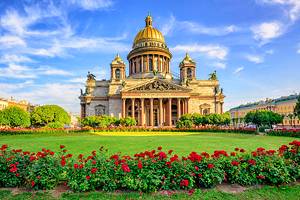
Exploring Russia: Whether you are interested in history, nature, or architecture, there's much to see in Russia. For a good introduction to some of the most fascinating spots in the country, take a look at our article on the Best Places to Visit in Russia . For more on Russia's second-largest city and all it has to offer, check out our piece on the Top-Rated Tourist Attractions in St. Petersburg .

- Skip to primary navigation
- Skip to main content
- Skip to primary sidebar
- Skip to footer
TravelAwaits
Our mission is to serve the 50+ traveler who's ready to cross a few items off their bucket list.
19 Unique And Fabulous Experiences In Moscow

- Destinations
Thinking of visiting Russia? When visiting such a famous city, one must, of course, visit the iconic landmarks first. Moscow has plenty of those, most of them in the center of the city, which is very well-planned for tourists. Once you’ve seen the sights that are on most travelers’ lists, it’s time to branch out and visit some of the lesser-known sites, and there are some fascinating places to see and things to do.
I know this list is long, but I just couldn’t help myself. You probably won’t have the time to see them all. But that’s okay. Just scroll through the list and choose what sounds the most interesting to you. Where possible, make sure to book in advance, as things can get crowded, especially during high season.

1. The Red Square, Kremlin, And Surroundings
Red Square (Krasnya Ploshad) is the heart and soul of Russia, and where much of the country’s history has unfolded. This is the most famous landmark in Moscow and indeed the whole country, it’s an absolute must-do! The square is always full of people and has a rather festive atmosphere!
Saint Basil’s Cathedral
This is the famous church with the rainbow-colored, onion-domed roof. The cathedral was commissioned in the 1500s by Ivan the Terrible and according to legend, the Tsar thought it was so beautiful, that he ordered that the architect’s eyes be cut out afterward, so he could never build anything more beautiful! He wasn’t called Ivan the Terrible for no reason!
Lenin’s Mausoleum
The “love-it-or-hate-it” of tourist attractions in Russia. A glass sarcophagus containing the embalmed body of Russian revolutionary, Vladimir Lenin. It may seem a bit bizarre to display the mummy of a person, but it has been there for almost half a century and the 2.5 million visitors who come each year, clearly feel the queuing and thorough body search are worth it, to be in Lenin’s presence.
Pro Tip: no photos and no loud talking are allowed inside the Mausoleum.
Eternal Flame
There is an Eternal Flame in honor of an unknown soldier on the left side of Red Square. The hourly changing of the guards is worth seeing.
The Kremlin is the official residence of the Russian president. You can see it from the outside, or you can take an excursion to one of the museums located inside. This is the biggest active fortress in Europe, and holds a week’s worth of attractions! Once behind the 7,332-feet of walls, there are five squares, four cathedrals, 20 towers, various museums, and the world’s largest bell and cannon to see. Worth a special mention is the Armory Chamber that houses a collection of the famous Faberge Eggs.
Pro Tip: You can only go inside the Kremlin if you are part of a tourist group.

2. Bolshoi Theatre
Bolshoi Theatre translates to “The Big Theatre” in Russian, and the building is home to both the Bolshoi Ballet and Bolshoi Opera — among the oldest and most famous ballet and opera companies in the world.
Pro Tip: It’s hard to get an inexpensive ticket, so if you’re reading well in advance of going to Moscow then try buying tickets on the official website . Last-minute tickets cost around $250 per person. If this is out of your budget, about an hour before a performance, you can try buying a ticket at the entrance from a reseller. Most can speak enough English to negotiate the price.
Tour the Bolshoi Theatre: You can take a group guided tour of the Bolshoi Theatre which focuses on the history and architecture of the theatre and behind the scenes. There’s an English language tour that lasts 2 hours and costs around $300 for a group of up to six.

3. Luxury Shopping At GUM And TSUM
Russia’s main department store, GUM, has a stunning interior that is home to over 100 high-end boutiques, selling a variety of brands: from luxurious Dior to the more affordable Zara. Even if shopping is not on your Moscow to-do list GUM is still worth a visit; the glass-roofed arcade faces Red Square and offers a variety of classy eateries. TSUM, one of the biggest luxury malls in town, is right behind the Bolshoi and GUM. It’s an imposing building with lots of history, and worth a visit just for its design and its glass roof.

4. Christ The Savior Cathedral
This is one of Russia’s most visited cathedrals and is a newer addition to the gorgeous array of Muscovite cathedrals, but don’t let its young age fool you. After perestroika, in the early 90s, the revived Russian Orthodox Church was given permission to build a cathedral on this site. It did the location honors and built the largest temple of the Christian Orthodox Church. The façade is as grand as you’d expect, but it’s the inside that will mesmerize you, with its domes, gold, gorgeous paintings, and decor!
The cathedral is located just a few hundred feet away from the Kremlin and was the site of the infamous Pussy Riot protest against Putin back in 2012.
Pro Tip: Bring a shawl to cover your hair as is the local custom.

5. Gorky Park
Moscow’s premier green space, Gorky Park (Park Gor’kogo) is the city’s biggest and most famous park. There is entertainment on offer here for every taste, from outdoor dancing sessions to yoga classes, volleyball, ping-pong, rollerblading, and bike and boat rental in summer. In winter, half the park turns into a huge ice skating rink. Gorky Park is also home to an open-air movie theater and the Garage Museum of Contemporary Art. There is also Muzeon Art Park, a dynamic contemporary space with a unique collection of 700 sculptures. It is located right in front of Gorky Park.
6. Sparrow Hills Park
If you take a walk from Gorky Park, along the Moscow River embankment, you’ll end up in the city’s other legendary park, Sparrow Hills. Although the park doesn’t offer as many activities as its hip neighbor, it has a great panoramic view of the city
Pro Tip: You can take a free walking tour to all of the above attractions with an English-speaking guide.

7. River Cruising
One of the best ways to experience Moscow, and see all the famous landmarks, but from a different angle, is from the Moscow River. Take a river cruise. Avoid the tourist crowds. There are little nameless old boats that do the cruise, but if you are looking for a more luxurious experience take the Radisson Blu cruise and enjoy the sights with some good food and a glass of wine.

8. Metro Hopping
Inaugurated in the 1930s, the Moscow Metro system is one of the oldest and most beautiful in the world. Started in Stalinist times, each station is a work of art in its own right. I’d recommend touring the stations between 11 a.m. and 4 p.m. This way, you’ll be able to properly see it without the crowds. Ideally, I’d recommend taking a tour with a knowledgeable guide with GuruWalk, who will tell you stories of forgotten stations and how the history of the country is interconnected with the metro development. If going by yourself, then I definitely recommend checking out: Mayakovskaya, Ploschad Revolutsii, Kievskaya, Kropotkinskaya, Kurskaya, and Novoslobodskaya stations.
Visit the free Moscow Metro Museum: For real train enthusiasts, located in the southern vestibule of Sportivnaya station is a small free museum. Here you can take a peek into the driver’s cabin, see a collection of metro tokens from different cities, and see different models of a turnstile, traffic lights, escalator, and more.

9. Moscow State University View
In his effort to create a grander Moscow, Stalin had seven skyscrapers built in different parts of town; they’re called the Seven Sisters. The largest of these buildings and the one with the best view is the main building of the Moscow State University. Although this is a little outside the city center, the view is more than worth it.

10. Izmailovsky Market
Mostly known for the city’s largest flea market, the district of Izmaylovo is home to a maze of shops where you can get just about anything, from artisan crafts to traditional fur hats, handcrafted jewelry, fascinating Soviet memorabilia, and antiquities. It’s also one of Moscow’s largest green spaces. There are often no price tags, so be prepared to haggle a bit. Head to one of the market cafes for a warming mulled wine before continuing your shopping spree.
The History of Vodka Museum is found here, and the museum’s restaurant is the perfect place to sample various brands of the national drink.
Once you’ve covered the more touristy spots, Moscow still has plenty to offer, and the places below will also be full of locals! So for some local vibes, I would strongly recommend the spots below!

11. Moscow City
With a completely different vibe, Moscow City (also referred to as Moscow International Business Center) is like a mini Dubai, with lots of impressive tall glass buildings. Here is where you’ll find the best rooftops in towns, like Ruski Restaurant, the highest restaurant both in Moscow City and in Europe. Moscow City is great for crowd-free shopping and the best panoramic views of the city.

12. Tretyakov Gallery
Tretyakov Gallery started as the private collection of the Tretyakov brothers, who were 19th-century philanthropists. They gave their private collection to the government after their deaths. If there is just one museum you visit in Moscow, I recommend this one!

13. Tsaritsyno Museum-Reserve
Tsaritsyno was a residence of Catherine the Great more than two centuries ago. It became derelict during the Soviet era but has now been fully renovated. With its opulently decorated buildings, gardens, meadows, and forests, Tsaritsyno Park is the perfect place for a green respite in Moscow.

14. Kolomenskoye
A 10-minute metro ride from the city center is Kolomenskoe Museum-Reserve, where you can get an idea of what Russia looked like 200 years ago. You’ll find ancient churches (one dating back to the 16th century), the oldest garden in Moscow, and the wonderful fairytale wooden palace of Tsar Alexey Mikhailovich, father of Peter the Great.

15. Ostankino TV Tower
Built in 1967, Ostankino TV Tower was the tallest free-standing construction in the world at the time, it’s still the 8th tallest building in the world and the highest in Europe. It’s also the best observation deck, with a glass floor and 360-degree views. The speedy elevators take you 1,105 feet in next to no time.
Pro Tip: You need to book in advance; entrance is based on specific ticket times and the capacity is limited and only a certain number of tourists are allowed per day. Don’t forget your passport, you’ll need it to get through security.

16. Zaryadye Park
Zaryadye is a newly opened, landscaped urban park so new you won’t find it in a lot of tour guides. The park is near Red Square and is divided into four climatic zones: forest, steppe, tundra, and floodplains, depicting the variety of climatic zones in Russia.
These last three suggestions are a little quirky, but all are really worth checking out.
17. Museum Of Soviet Arcade Games
Release your inner child playing on 66 arcade machines from the Soviet era! What a great way to spend a couple of hours when tired of visiting museums and palaces. The staff speaks excellent English and are happy to explain how the games work.

18. Moscow Rooftop Tour
Take a 1-hour private Moscow rooftop tour with an experienced roofer. I can just about guarantee none of your friends will be able to say they’ve done it! For your comfort, I recommend wearing comfortable shoes. Take your camera, there are some amazing photo opportunities out there!

19. Sanduny Banya
This classical Russian bathhouse opened its doors in 1808 and is famous for combining traditional Russian banya services with luxurious interiors and service. If you enjoy spas and saunas, then you should experience a Russian bathhouse at least once in your life! Go with an open mind and hire a specialist to steam you as it’s meant to be done — by being beaten repeatedly with a besom (a leafy branch)! This is said to improve circulation, but is best done by a professional!
So there you have my list of things to do in Moscow. I could have gone on and on and on, but I didn’t want to try your patience! There are so many things to do in this vibrant city that you’ll definitely need to allocate several days for exploring.
Here are some other reasons to visit Moscow and Russia:
- 7 Reasons To Put Moscow On Your Travel Bucket List
- Russia 30 Years (And 30 Pounds) Ago
- Massive Mysterious Craters Appearing Again In Siberia

Born and raised in Sydney, Australia, before moving to Africa at the age of 21, Sarah Kingdom is a mountain climber and guide, traveler, yoga teacher, trail runner, and mother of two. When she is not climbing or traveling she lives on a cattle ranch in central Zambia. She guides and runs trips regularly in India, Nepal, Tibet, Russia, and Ethiopia, taking climbers up Tanzania’s Mount Kilimanjaro numerous times a year.
THE BEST Cabadbaran Sights & Landmarks
Cabadbaran landmarks.
- Points of Interest & Landmarks
- Churches & Cathedrals
- Good for Kids
- Good for Big Groups
- Adventurous
- Budget-friendly
- Good for a Rainy Day
- Hidden Gems
- Good for Couples
- Honeymoon spot
- Good for Adrenaline Seekers
- Things to do ranked using Tripadvisor data including reviews, ratings, photos, and popularity.

1. Cabadbaran

2. Our Lady of the Assumption Church
9 Things to See in Moscow's Red Square
Sir Francis Canker/Getty Images
In most cases, you'll be entering Red Square from the north, passing landmarks such as the Bolshoi Theatre and Duma parliament building as you make your way southward. Although you don't necessarily have to pass through the Voskresensky (or Resurrection in English) Gates in order to gain access to the square these days, they definitely provide a sense of arrival, to say nothing of the way their left arch frame's St. Basil's Cathedral if you look from just the right angle.
An interesting fact is that while a gate of some kind has stood here since the mid-16th century, the one you currently see wasn't built until 1994, having been destroyed in 1931 so that tanks could enter and exit Red Square during military parades.
St. Basil's Cathedral
TripSavvy / Christopher Larson
Few sights are as iconic not only of Moscow and Red Square but indeed of Russia than St. Basil's Cathedral, whose colorful, onion-shaped domes are a symbol of the country around the world. Officially known as the Cathedral of Vasily the Blessed, this church has stood since 1561, which is quite miraculous when you consider all the turbulent history that has transpired since then.
Among other things, religion was severely prohibited during the Soviet period , which led some to believe that this emblem of the Russian Orthodox church might not withstand the tenure of the USSR.
An interesting fact is that St. Basil's is the so-called "Kilometer Zero" of Russia; all of Moscow's main roads (which can take you anywhere in Russia) begin at the exits to Red Square. In this way, St. Basil's iconic status also has an extremely tangible element.
The Kremlin
TripSavvy / Christopher Larson
When you think of The Kremlin, it's unlikely that positive images enter your mind. The fact that simply saying the word "Kremlin" is too vague a descriptor (most Russian cities have their own Kremlin complexes; you should say "Moscow Kremlin") notwithstanding, this misunderstood place is incredibly beautiful, even if you don't like the policy that comes out of it.
Senate Square
In spite of its name, which refers to the role the building that rises above the square played during Imperial Russia, Senate Square is actually home to Russia's presidential administration, currently helmed by Vladimir Putin. In order to see where Russia's legislature operates from, walk just outside Red Square to the Duma parliament building.
Dormition Cathedral
Dating back to the year 1479, the gold-domed Dormition Cathedral pays homage to an Orthodox religious feast that commemorates the death of the Virgin Mary . As is the case with St. Basil's, it is curious that such a conspicuously religious structure was able to survive through the Soviet period.
Armoury Chamber
Though it takes its name from the fact that it housed Russia's royal arsenal when it was built in the 16th century, the most notable resident of the Kremlin's Armoury Chamber today is the Russian Diamond Fund.
Notable Kremlin Towers
Robert Schrader
The interior of the Moscow Kremlin is more beautiful and inviting than you'd expect, but the walls and towers that rise around it better live up to the intimidation with which the complex is associated.
Borovitskaya Tower
Named to commemorate the dense forest that once stood atop the mount where it's built, this tower is extremely picturesque. Built in the late 15th century, it's visible from most places in the square, and also as you walk along the Moskva River.
Nikolskaya Tower
Also built in the year 1491, this tower currently suffered destruction at the hands of Napoleon's army in the 19th century. What you see now is the result of an 1816 re-design and renovation, though artillery fire during the Russian Revolution also caused superficial damage to the tower, named to honor St. Nikolas of Mozhaysk , so it's difficult to know which elements of it are original.
Spasskaya Tower
Known in English as the "Savior's Tower," this iconic, star-topped tower is perhaps the best-known of all the Kremlin's towers. Built in 1491 like the other two towers on this list, it's certainly the most photographed. As a result of its proximity to St. Basil's, it often makes its way into tourists' pictures.
Mausoleum of Lenin
Just as it's strange to learn how many religious monuments survived through the Soviet period, it's a bit odd to think that Lenin's preserved body still sits in a mausoleum just beneath the walls of the Kremlin on Red Square, given the lack of consensus about the ultimate impact of his Revolution, even in Russia.
It's not guaranteed that you'll be able to see the body (which, believe it or not, seems to be improving with age ) when you go, and if you do you will likely have to wait in line, but even strolling past the outside of the Lenin Mausoleum, flanked by stone-faced guards that almost look like statues, illuminates the gravity of his body still being here.
GUM Shopping Center
You might cringe, at least initially, when you realize that one of the most iconic stops on a tour of Red Square is a department store—until you see said department store, that is. Built in 1893 and known during Soviet times as the State Department Store, GUM ( Glávnyj Universáľnyj Magazín or Main Universal Store in English) hearkens back to the grandeur of the late 19th century, both seen from the outside (especially, when lit up at night) and the interior, which might have you feeling like you're further west in Europe.
A trip inside GUM is a particularly good idea during winter, when frigid temperatures outside will have you savoring the heat, the quality of souvenirs, confections and other goods sold inside notwithstanding. Also, make sure not to confuse GUM with CDM, which sits near the Bolshoi Theatre, even though both are stunning and iconic in their own right.
State Historical Museum
The Russian State Historical Museum is located near Voskresensky Gates, though you should wait until after you've seen the first few attractions of Red Square and the Kremlin to head back there and go inside. To be sure, as you pass by its facade (whose late-19th century grandeur somewhat obscures that fact that it's currently a museum accessible to the public) you might not even think to try and gain entry.
Once inside the museum, you can plan to spend at least a couple of hours, given that artifacts here date back to the very beginning of the Russian state in the ninth century. As is the case with GUM, this will be a particularly alluring prospect if you visit in winter, when Moscow is arguably at its most beautiful, but certainly at its least tolerable.
Minin-Pozharsky Monument
It's somewhat easy to disregard this monument, which pays homage to the two Russian princes who ended the so-called "Time of Troubles" in the mid-16th century, during which Polish-Lithuanian forces occupied Russia, among other awful things including a famine. That's because the statue currently sits just at the base of St. Basil's Cathedral, which makes it very difficult to photograph or even see without being overwhelmed by that much more famous edifice.
Though the statue originally sat at the very center of Red Square, it came to be an obstacle to the movement of tanks during the Soviet period, much like the Voskresensky Gates. As a result, authorities moved it during that time, and it's stayed where you currently find it ever since.
Kazan Cathedral
Taken by itself, the smokey-pink Kazan Cathedral is an architectural marvel; originally built in the 17th century, the church you find here today, located just north of the GUM department store, dates back only to 1993.
Unfortunately, since it sits not only in the shadow of GUM, but also in the shadow St. Basil's and the Towers of the Kremlin, it's easy to miss entirely if you aren't looking. As a result, you might wait until you've seen just about everything else in Red Square before coming here to take photos, and to appreciate the understated beauty of this oft-overlooked cathedral.
Moskva River
As you head south from St. Basil's Cathedral to exit Red Square, make sure to walk onto Bolshoy Moskvoretskiy Bridge, which crosses the Moskva River. If you look due north, you can get an excellent shot of the church framed, on the left, by the towers of the Kremlin. Directing your gaze a bit to the west allows you to see the skyscrapers of Moscow City as they rise above the Kremlin's walls.
Walking westward along the riverbank is also a worthwhile excursion, for the views it provides of Red Square and the Kremlin, as well as the fact that doing so takes you to other iconic Moscow attractions, including Gorky Park and the Pushkin Museum. The views you enjoy from the river and the bridge are particularly stunning at night, though you should make sure you bring a tripod if you want to get a clear picture, given how strong winds over and near the river can be.
Moscow - Russian Rivers and Waterways Port of Call
Moscow Metro: The Complete Guide
25 Best Things to Do in Moscow
The Impressive Castles of Eastern Europe
St. Basil’s Cathedral in Moscow: Planning Your Visit
St. Petersburg, Russia
10 Must-Visit Palaces and Castles in Russia
Top 12 Things to Do in Kazan, Russia
The Top 12 Things to Do in Nizhny Novgorod, Russia
The Top 12 Things to Do in Novgorod, Russia
Soviet Sights in Moscow – Moscow USSR Sites
The Top 12 Things to Do in Astrakhan
The Top 15 Places to Visit in Russia
A Guide to Moscow: Capital of Russia, City of Domes
The Top 15 Things to Do in Bordeaux, France
A Guide to the 4th Arrondissement in Paris
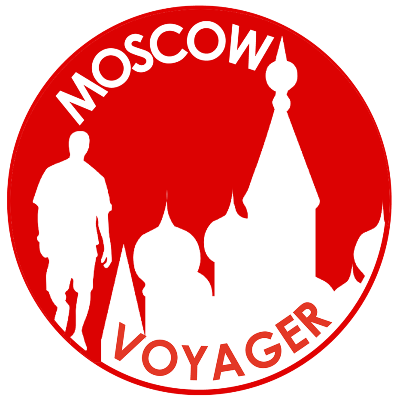
Moscow’s Top 13 – The Main Attractions of the Russian capital

13 Moscow Attractions
One of the most fascinating metropolis, breathtaking city, and a vibrant European capital, Moscow is a powerful mix of history and edginess, full of world famous sites and attractions that are worth exploring. However, it would take weeks to really explore all facets of the Russian capital – unfortunately hardly any traveler has that much time, which is why you should concentrate on the absolute Moscow top attractions and highlights. Here is the list of top 13 Moscow attractions you can choose on your next Russian travel journey.
What Times Square means to New York, Pariser Platz with the Brandenburg Gate to Berlin, or Trafalgar Square to London – Red Square means to Moscow. The heart of Russia’s capital it is the central meeting point and the most famous photo opportunity. No place stands for Russia and Moscow more than “krasnaja ploshchad”, as Red Square is called in Russian.
It is arguably one of the Moscow main attractions and most visited. With the gigantic military parade on Victory Day in World War II, which takes place every year on May 9, the pictures of the square go around the world year after year. But for the rest of the year you will mainly meet local and foreign tourists here, who take peaceful pictures and soak up the unique spirit. The square looks spectacular illuminated at night, but you should visit the square at least once in daylight as well.

If you stand in the middle of the huge cobblestone square, in the clockwise direction you can see the Kremlin and the Kremlin Wall with a total of 20 individually designed towers, Lenin’s Mausoleum, Historical Museum built with red bricks, the little Kazan Cathedral, the impressive luxury department store GUM, the imposing St. Basil’s Cathedral and, the bridge over the Moskva River. This unique ensemble offers more sightseeing highlights at one stroke than any other tourist attractions in Moscow or the world.
So it’s no wonder that Red Square is UNESCO World Heritage Site and offers the most popular photo opportunities worldwide. When visiting Moscow, there is no reason not to visit to Red Square and a selfie is practically also a must – getting there is easy even for Russia newcomers. Although Red Square does not have its own metro station, it is still child’s play to find the way there – especially since the Square is the absolute geographical center of the city.
There are four metro stations in the vicinity, from which it is only a short walk to Red Square, Okhotny Ryad and Teatralnaya directly at the northwest entrance of the Square at the Historical Museum; further to the west is the Lenin Library station, from which one arrives at the same entrance through the Alexander Garden. As well as the station Revolution-square behind the GUM department store, which leads past to the northeast side of the Square.
The Kremlin
This is the biggest active fortress in Europe offering a week’s worth of attractions. For more than 70 years, the Kremlin was the power center of the Soviet Union, which the US President Ronald Reagan called the Empire of Evil exactly 35 years ago, one of the symbols of the East-West conflict in the Cold War. People in the West feared the «dark» plans that were built behind the thick walls of the Kremlin.
The Kremlin is built in a triangular shape on the natural elevation above the Moscow River, known today as the Kremlin Hill. Today’s metropolis Moscow has expanded in a circle around it and the road around the Kremlin is considered the first of several ring roads in Moscow counting.
Now Kremlin has lost its terrifying image, although it is still the seat of the Russian President and thus one of the most important places in World political events. It is an inviting, historical sight for tourists, and one of the famous Moscow tourist attractions which can be visited for just a few dollars.
The large parts of the 28 hectare site can be visited by tourists – with the exception of the Kremlin towers, the presidential Grand Kremlin Palace and the Senate Palace. The first port of call on the site is the so-called Cathedral Square, which is the geographical center of the Kremlin and at the same time the highest point on the Kremlin Hill and contains the three oldest structures in the complex. The three 15 th -century cathedrals of the Kremlin (the Dormition, Archangel Michael and the Annunciation Cathedrals), which together with the Ivan the Great Bell Tower and the Cathedral of the Deposition of Mary, make the most famous ensemble of the Kremlin. Also to be visited here are primarily the Armoury and the Patriarch’s palace.
To get to the Kremlin, you have to pass a security gate at one of the two publicly accessible entrances – these are located at the Kutafja and Borovitsky towers. Tickets cost from 700 rubles upwards, the admission to the Armoury, the Ivan the Great bell tower and the Patriarch’s Palace being paid for separately.
More about the Kremlin
Lenin’s Mausoleum
This is the ultimate love it or hate it tourist attractions in Moscow It may be mistaken for a gloomy performance, but Lenin remains an absolute attraction almost a hundred years after Vladimir Lenin death. The founding father of the Soviet Union is not only a fascinating historical figure of world renown for supporters of communism. Despite ongoing discussions about a final burial of the leader of the communist October Revolution in 1918, hundreds of thousands come year after year to the dark marble building on Red Square, right next to the Kremlin wall, to see the embalmed body of the legendary Russian revolutionary.
First opened to the public in 1924, the Mausoleum attracts 2.5 million visitors every year, so, visitors have to wait a long time to get into the illustrious building. Also, photos from inside the Mausoleum are prohibited. But a visit is still a must for Moscow visitors, especially since the visit is free. Please note that the Mausoleum is only open on Tuesdays, Wednesdays, Thursdays and Sundays from 9 a.m. to 1 p.m.
The queue starts behind the Historical Museum and before you get into the actual mausoleum, you have to pass an airport-like security gate – cameras and cell phones are not allowed into the Mausoleum, but can be safely placed in a cloakroom for a small fee. On the way out of the Mausoleum, after the visit, you pass the graves of the other Soviet heads of state. Including the grave of Josef Stalin, who was briefly kept next to Lenin in the Mausoleum after his death. But in the course of de-Stalinization, the cruel dictator was moved to the less prominent place behind the Mausoleum.
More about the Lenin Mausoleum
The Alexander Garden (Alexandrovsky Sad)
If you visit Moscow in summer, the hustle and bustle in the metropolis of millions can get over your head. The city, best known for its icy winters, can turn into an absolute burning furnace in summer. It sometimes takes over an hour to get to the edge of the metropolis. The perfect retreat, located in the center of Moscow, is therefore the Alexander Garden and one of the Moscow top attractions.
Located directly on the western wall of the Kremlin, the Alexander Garden is just a small, but all the more well-kept park that extends to the nearby Manege Square (Manezhnaya Ploschad). The garden undergoes a lot of changes, with old trees cut down in 2012 and over 200 planted, the authorities also claim that there will be a rosary of 3000 roses. As soon as the first rays of sun warm up the Muscovites, tormented by the long winter, they set off into the countryside. If you are right in the center, you can choose the small park right by the Kremlin.
With a café in hand, which you can get yourself on Manege Square, you can linger here between the carefully tended flower beds. With the Grave of the Unknown Soldier and the regular changing of the guard, there is even a real tourist attraction on top. Entry is free.
The Moscow Metro
In no other metropolis in the world would the subway be declared a sight. Yes, that is truly right as riding this one of the top Moscow tourist attractions is an experience in itself or just a walk through the station is amazing in itself. Whether in New York, Berlin, London or Paris – the big city inhabitants of the world metropolises have a love-hate relationship with their metro. It’s different in Moscow – the residents of the Russian metropolis love their metro and there is a reason for that: in the early days of metro construction, dictator Stalin had built the stations into “palaces for the workers”.
All the splendor of the tsars, which the ordinary Russian never saw, is now open to everyone, regardless of their origin. Indeed, a number of stations on the Moscow Metro, each built shortly before or after the war, are unmatched architectural masterpieces. Mayakovskaya station is often compared to a ballroom for its chandeliers and ornaments. The Teatralnaya stop, located directly below the world-famous Bolshoi Theater, shines with decorations reminiscent of the country’s theater and ballet tradition. Colorful glass windows, almost like in a sacred building, adorn the Novoslobodskaya station.
But the uncalled queen among Moscow’s metro beauties is Komsomolskaya station, named after the youth organization of the Soviet Union. With its huge chandeliers and detailed ceiling decorations, it is the crown jewel among the 331 metro stations. It is not uncommon for tourists to stand in the middle of the platform and take photos under the glances of passengers who just want to walk past the annoying tourists to and from work as quickly as possible.
A ride on the metro currently costs 57 rubles, which is less than one dollar. You should plan a few hours for a tour of the most beautiful stations, but the good news is, once behind the turnstile, a single ticket is enough to stay in the metro system as long as you want.
The Bolshoi Theater
To see Tchaikovsky Swan Lake or the Nutcracker by the same legendary Russian composer on the famous Bolshoi stage – that is the dream of every ballet fan. Home to the largest and one of the oldest ballet and opera companies in the world, nowhere else is the fine art of musical dance lived as much as in Russia – and has been since the times of the tsars.
The Bolshoi itself has been shining back to its former glory since it was built in 1776 since its extensive renovation that cost almost a billion dollars a few years ago. The large historical hall of the building impresses with its opulent golden decorations and creates a very special atmosphere – this was also used by the communist leaders of the Soviet Union, who held their congresses in the building directly at the Kremlin. The Theater is so famous that it currently adorns the 100 ruble banknote and is among the Moscow main attractions.
If you’d like to go to what is probably the most famous ballet theater in the world today, it’s easier than ever. The program can be found months in advance on the official website bolshoi.ru and can be ordered at very reasonable prices. The cheapest seats in the hall can be booked for as little as 100 rubles, i.e. less than $ 2. However, you should reserve tickets early, as the performances are usually booked weeks in advance. Even for good seats, you pay very moderate prices compared to Western Europe.
There are a few things to watch out for, however, proper, appropriate clothing is welcome, but apart from the obligation to wear trousers, it is not an exclusion criterion for men. If you arrive late, you have to wait outside until the next break so as not to disturb the other guests during the performance. The best way to get to the Bolshoi is by taking the Moscow Metro via the Teatralnaya station, which was built especially for the theater and which stairs are right in front of the main entrance.
More about the Bolshoi Theater
The GUM department store
The Russian abbreviation GUM means main all-purpose shopping center and sounds quite formal for such a shopping temple. Located in front of the Kremlin on Red Square, GUM has existed as a department store since 1920 and was previously a market. It is the most iconic and largest department store in Russia and among the Moscow tourist attractions . The facade of the building, built in 1890, fits perfectly into the overall picture of Red Square and is illuminated photogenically at night.
In contrast to the scarcity economy of the Soviet era, the GUM today really has everything to offer that one can imagine. It has become the flagship of the shopping and fashion metropolis Moscow. But today you will mainly find smaller luxury shops here. From western high-couture boutiques such as Prada or Gucci to fur for the icy Russian winter, a well-to-do Muscovite or a tourist will find everything their heart desires here.
People can walk through the wide and beautifully decorated arcades of the GUM, free of charge. Cafes invite you to linger. A delicatessen shop on the ground floor sells Russian specialties at affordable prices. Chocolate, honey and caviar, as well as the all-round vodka in Russia, can be bought here as souvenirs for friends and family at home. In addition, the Soviet-style cafeteria on the upper floor is very cheap for lunch.
The GUM offers a special highlight every winter when the department store administration built an ice rink in front of the building directly on Red Square. For only 200 to 300 rubles per hour, depending on the time of day, you can lace up your skates and glide over the ice with the unique panorama of Red Square.
More about the GUM department store
The Historical Museum
The Historical Museum is a museum of Russian history wedged between Red Square, Lenin Mausoleum, small Kazan Cathedral, and Manege Square. The red brick building of the Museum is a real eye-catcher and Moscow top attractions located on the opposite side of St. Basil’s Cathedral. It is dedicated to Russian history and is built in the Old Russian style, the building did not open until 1883.
The Museum houses everything from an exhibition on the archeology of Russia, through the technological achievements, to the art of the gigantic empire in 16 sections and has a total of 5 million exhibits. So if you are interested in the history of Russia, you cannot avoid visiting this Museum and should plan enough time for it.
A visit costs 150 to 500 rubles, depending on which exhibition you want to visit. The Museum is open in winter, autumn and spring from 10 a.m. to 6 p.m., on Saturdays from 10 a.m. to 9 p.m., closed on Tuesdays. In the summer months, the extended Saturday times apply daily.
It is probably the most famous park in the Russian capital and the top Moscow tourist attractions – a novel and its film adaptation and a Russian rock band have its name and numerous songs by Russian and international bands and TV series, such as House of Cards, mention it or act here. Gorky Park is a premier green space offering entertainment for every taste. Located southwest of the center of Moscow on the Moskva River, it is designed more for family attractions and rest and the classic park on the other side – has become one of the meeting places for Muscovites of all kinds in recent years.
Whether for a yoga class, a family picnic or beach volleyball match, skateboarding, and cycling – people meet here often. Because even in the Gorky there is an ice surface in winter, the largest in Moscow, which attracts many Moscow residents as well as tourists.
A large-scale renovation in 2011 breathed new life into the park – the roller kiosks were removed and more emphasis was placed on the maintenance of the green spaces. The park remained free of charge and developed into one of the most popular places in the capital. Whether with the rental bike through the green lungs, the pedal boat across the numerous ponds or simply watching the goings-on on the park bench – a visit to Gorki is also absolutely worthwhile for tourists.
Day trip to the Golden Ring
As much as the metropolis Moscow is fascinating, the side effects of a cosmopolitan city like Moscow – the noise, the traffic and the crowds – can overwhelm any tourist. What could be better than a day trip to escape the organized chaos of the cosmopolitan city?
The places on the Golden Ring near Moscow are an ideal destination for this and among the Moscow main attractions – located north-east of the metropolis, these old Russian cities, some of which have existed for much longer than Moscow itself, offer a welcome change from the hectic hustle and bustle of the capital.
Developed in the late 1960s uniting several mediaeval Russian cities located to the north-east of Moscow it is the most popular route around provincial cities of central Russia. More than a thousand year old city of Yaroslavl on the Volga is the largest, but at 260 km from Moscow also the most distant city of the Golden Ring. For only 650 rubles, however, you can take the three-hour train ride there.
Yaroslavl has been part of the world cultural heritage since 2005 and is best known for its two monasteries – the Monastery of our Savior and Transfiguration and the Monastery of the Assumption of the Virgin Mary in Tolga are located directly on the Europe’s longest river Volga and its inflow Kotorosl. Both testify to the long history of the Russian Orthodox Church. The cityscape of Yaroslavl is also really worth seeing with its classicist buildings – walking through the streets of the city with 500,000 inhabitants is a welcome contrast to Moscow. Things are even more slow in the small towns of Suzdal and Vladimir, both of which can still be reached with the Moscow suburban train network (known as Elektrichka) for a good 500 rubles. In both cities time seems to have stood a little – large sacred buildings dominate the cityscape.
Especially the Assumption Cathedral, located in the center of Vladimir, and the Golden Medieval Gate are the main attractions for tourists. The church, built in the early 12th century, is best known for its almost 700 year old wall paintings and frescoes and is a World Heritage Site. The Suzdal Kremlin is also part of the UNESCO World Heritage List and was first mentioned in writing in 1024.
Suzdal with its only 10,000 inhabitants has still retained the character of a small Russian town and in the town, which will celebrate its millennium in 2024, you can still find numerous wooden buildings typical of rural Russia – whether churches or houses, the colorful buildings are ideal as Photo motif and give an impression of the simple Russian provinces life away from the metropolises.
The exhibition of the achievements of the national economies is not in every travel guide as a classic Moscow main attractions and a must see of the Russian capital. But no other place in the modern mega-metropolis exudes the spirit of the Soviet Union as much as the enormous VDNKh (All Russian Exhibition Centre) in the north of Moscow. It was built as an agricultural exhibition before World War II, but was then renamed world exhibition for the 15 individual Soviet states and their achievements.
From the Armenian, Estonian and Kyrgyz culture, to the Soviet achievements in space travel and nuclear power, to statues about the heroes of the Soviet history, the VNDKh (Vystavka Dostizheniy Narodnogo Khozyastva) was an absolute attraction until the fall of the Soviet Union in 1991. After that, the old charm fell into disrepair and the large central pavilion, which was built in the splendidly pompous Stalinist style, was filled with small traders selling souvenirs and matryoshkas.
Since its renovation in 2014, the exhibition in the park-like area is absolutely worth a trip again and with the metro station of the same name you can get from the center to the VDNKh quickly and without problems. There are still strange souvenirs, plus huge Soviet monuments worth seeing, as well as numerous rides for children. The Kosmos exhibition still exists and is now part of the Cosmonaut Museum, which is located at the front end of the park when coming from the metro station.
Here you can experience the various achievements of Soviet and Russian space travel vividly. From the very first Sputnik satellite, the spacesuit of Yuri Gargarin, the very first human in space, to the Buran space shuttle, you can learn an incredible amount about the conquest of the cosmos here. However, you should plan several hours just for a visit to the Cosmonaut Museum.
More about the cosmonaut museum
The Pushkin Museum and the Tretyakov Gallery
To complete the cultural program in Moscow, you should definitely make a tour to the Pushkin Museum and the Tretyakov Gallery when visiting the Russian capital. It is the largest museum of European art and among the Moscow top attractions. The former Museum of Fine Arts was named after Alexander Pushkin’s death in 1837 – it is still one of the most important art collections in the world today.
It boasts one of the richest collections of foreign art in Russia, showcasing global artistic developments from early times to the present day in expositions numbering 700,000 works of art. Not far south of the Kremlin, exactly opposite the Cathedral of Christ the Savior, the Museum is housed in a classic building specially built for this purpose in 1898. From early Byzantine art to the famous Madonna by Lukas Cranach, the Italian masters, Peter Paul Rubens and masterpieces of Expressionism, for example by Paul Cézanne, you can admire a huge selection of important art here.
The regular entry ticket costs 800 rubles and the Ьuseum is open on weekends from 11 a.m. to 8 p.m., during the week until 8 p.m. – only Monday is closed.
The second important art collection in the capital is the State Tretyakov Gallery. It is the national treasury of Russian fine art and one of the greatest museums in the world. Started by the textile entrepreneur and philanthropist Pavel Tretyakov as a collection of local contemporary art in 1851, the gallery has now developed into one of the cultural highlights of Russia. In contrast to the Pushkin Museum, you will primarily find Russian art from the 19th century and older icons.
Entry cost is 400 rubles and the Gallery is open daily from 10 a.m. to 7 p.m. – Monday is also the day off.
Take a stroll across Red Square, meet Lenin and see the world-famous Kremlin?
Then first of all you need a visa! !
Alexander Popov
Welcome to Russia! My name is Alexander, I was born in Moscow and I'm a passionate tour guide. I want to share my passion for Russia and my hometown with you. On my website you will find useful information to make your individual trip to Russia as interesting as possible.
The Museum of Cosmonautics and the Planetarium in Moscow
Gorky park and sparrow hills: green lungs, place to relax and meet, you will also like, everything you need to know about russia: included..., traveling in russia – how safe it is..., choosing the best guide for a free and..., how do i exchange money in moscow, eating out in moscow, the best time to travel to russia, how do i get from moscow airports to..., the best taxi services in moscow, moscow’s best free city tour, with sim card purchase in russia: use whatsapp,..., leave a comment cancel reply.
Save my name, email, and website in this browser for the next time I comment.
@2019-2020 - Moscow Voyager. Alexander Popov
We use cookies to provide you with a better experience. By continuing to use our site you accept our cookie policy. Accept Read More

IMAGES
VIDEO
COMMENTS
One of the treasures of Cabadbaran's history is steeped in antiquity, reaching back to 1200 A.D. Ancient villages from the 12th century once thrived along the region's waterways, such as Caasinan, Cambuayon, and Capudlusan. These pre-Spanish Cabadbaranon's shared an era with the archaeological sites in Butuan City, and today, their ...
Here are 10 places you should visit in Cabadbaran. 1. Atega ancestral house. With 30 rooms, this house is the biggest and most beautifully-preserved ancestral house in Cabadbaran. Location: Cabiltes Street. 2. Casa Alburo. Location: L. Dagani corner A. Mortola Sts. 3.
Things to Do in Cabadbaran. 1. Cabadbaran. It was declared recently in 2010 and as such it is not a very well known destination. A poor neighbor to progressive... 2. Our Lady of the Assumption Church. Things to Do in Cabadbaran, Philippines: See Tripadvisor's and photos of Cabadbaran tourist attractions. Find what to do today, this weekend, or ...
Cabadbaran Attractions - What to See and Explore. Cabadbaran offers many attractions and places to visit. Here are the most important ones: Cabadbaran City, Atega Park, Cabadbaran City Hall. Below you will find a complete list of places worth visiting. 9°7'24"N • 125°31'55"E.
Cabadbaran Tourism: Tripadvisor has 26 reviews of Cabadbaran Hotels, Attractions, and Restaurants making it your best Cabadbaran resource. Skip to main content. Discover. Trips. ... Places to see, ways to wander, and signature experiences. See all. Cabadbaran. 6. Points of Interest & Landmarks. Magellan's Landing Site. 21. Historic Sites.
Top Things to Do in Cabadbaran, Philippines. Places to Visit in Cabadbaran. Enter dates. Attractions. Filters. Sort. Map. Category types ...
Located just 31 kms from Butuan Airport, Cabadbaran City is the capital of the province of Agusan del Norte with budding tourism potential slowly carving its niche in the tourism market. The city's subtle offerings usher in adventure seekers and cultural aficionados, giving them a sweet surprise of how the city's unassuming tourism has ...
1. Cabadbaran. It was declared recently in 2010 and as such it is not a very well known destination. A poor neighbor to progressive... 2. Our Lady of the Assumption Church. Things to Do in Cabadbaran, Philippines: See Tripadvisor's 26 traveller reviews and photos of Cabadbaran tourist attractions. Find what to do today, this weekend, or in April.
Top Cabadbaran Landmarks: See reviews and photos of sights to see in Cabadbaran, Philippines on Tripadvisor.
Tourist Spots . Cabadbaran Ancestral Houses - an old Spanish architecture houses. The most prominent among them is the Atega Ancestral Home, the biggest and most beautifully preserved house, located at Caraga. Cabadbaran Museum - a repository to the town's old documents, as well as artifacts from Cabadbaran's 4 archeological sites.
Cabadbaran Tourist Spots: Atega Ancestral House - Preserving Heritage Through Time. The Atega Ancestral House is a testament to the rich cultural legacy and architectural wonders of the Philippines. This historic gem showcases the enduring legacy of Filipino craftsmanship and design. The house, characterized by its sturdy hardwood beams and ...
Things to Do in Cabadbaran. 1. Cabadbaran. It was declared recently in 2010 and as such it is not a very well known destination. A poor neighbor to progressive... 2. Our Lady of the Assumption Church. Things to Do in Cabadbaran, Philippines: See Tripadvisor's 26 reviews & photos of 2 Cabadbaran attractions.
8. Sprinkles Water Park and Event Center. 9. Bood Eco Park. 10. Guingona Park. ... Discover the best things to do in Cabadbaran City, from iconic attractions to hidden tourist spots. Find exciting places to visit near Cabadbaran City and enjoy fun activities.
Jul 2018. Cabadbaran city is the new city in Agusan del Norte. It was declared recently in 2010 and as such it is not a very well known destination. A poor neighbor to progressive Butuan city, the streets are quire rural in nature. Nonetheless, what it may lack in progress is compensated by the very beautiful scenery that surrounds Cabadbaran city.
Surprising Sumag-a Falls of Mahaba, Cabadbaran City is the most unique of all the waterfalls in Caraga Region. Aside from crystal clear and cold running water it has no river or streams above it but simply it goes nowhere but underground clear water breakout in the hilly part of Mahaba mountains. Sumag-a falls has a man-made basin as a swimming ...
Cabadbaran City Tourism, Culture and Arts Office. 6,711 likes · 1 talking about this · 37 were here. CABADBARAN CITY . . . Land of crystal clear waters....
A poor neighbor to progressive... 2. Our Lady of the Assumption Church. Top Things to Do in Cabadbaran, Philippines: See Tripadvisor's 26 traveller reviews and photos of Cabadbaran tourist attractions. Find what to do today, this weekend, or in April. We have reviews of the best places to see in Cabadbaran. Visit top-rated & must-see attractions.
Spend a rainy day at the Tretyakov Gallery. 10. Walk Up and Down Arbat Street. 11. Stop by the VDNKh All-Russian Exhibition Centre. 12. Wander Around Gorky Park. Where to Stay in Moscow for Sightseeing. Map of Tourist Attractions & Things to Do in Moscow.
The "love-it-or-hate-it" of tourist attractions in Russia. A glass sarcophagus containing the embalmed body of Russian revolutionary, Vladimir Lenin. It may seem a bit bizarre to display the mummy of a person, but it has been there for almost half a century and the 2.5 million visitors who come each year, clearly feel the queuing and ...
6. Points of Interest & Landmarks. By KIMI4812. It was declared recently in 2010 and as such it is not a very well known destination. A poor neighbor to progressive... 2. Our Lady of the Assumption Church. Churches & Cathedrals. Top Cabadbaran Landmarks: See reviews and photos of sights to see in Cabadbaran, Philippines on Tripadvisor.
St. Basil's Cathedral. Few sights are as iconic not only of Moscow and Red Square but indeed of Russia than St. Basil's Cathedral, whose colorful, onion-shaped domes are a symbol of the country around the world. Officially known as the Cathedral of Vasily the Blessed, this church has stood since 1561, which is quite miraculous when you consider ...
Gorky Park. It is probably the most famous park in the Russian capital and the top Moscow tourist attractions - a novel and its film adaptation and a Russian rock band have its name and numerous songs by Russian and international bands and TV series, such as House of Cards, mention it or act here. Gorky Park is a premier green space offering ...